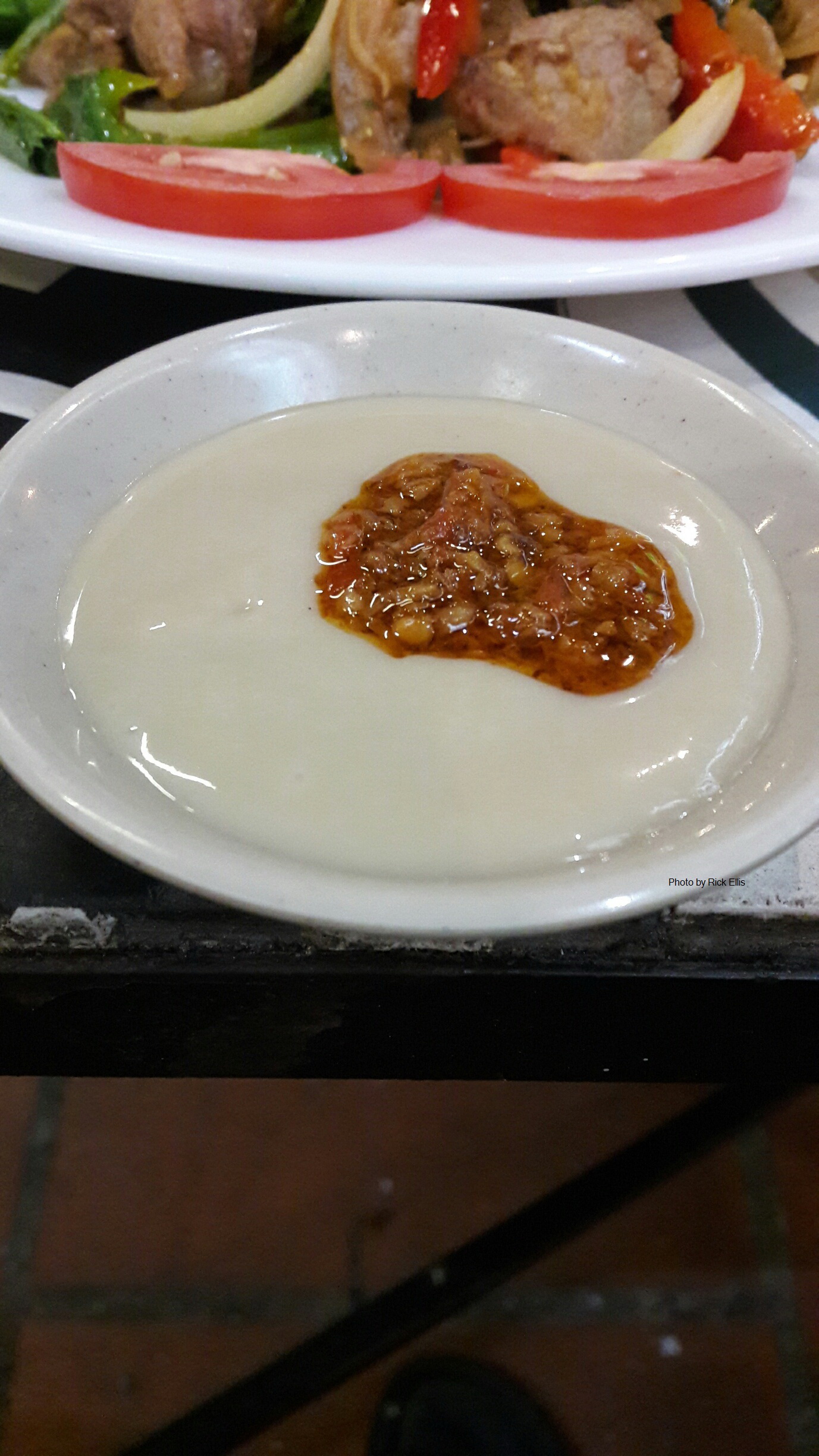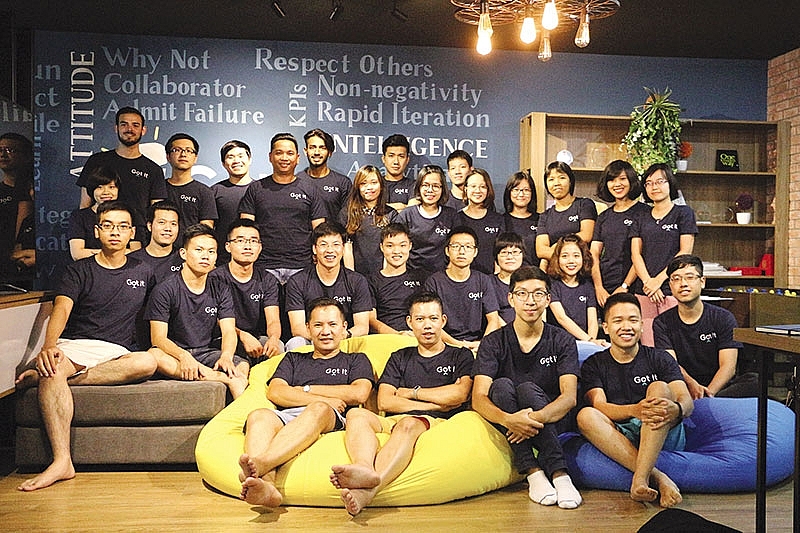Foreigners celebrate Vietnam’s Lunar New Year A new year has already arrived, bringing great joy to Vietnamese people and their international friends. Tet or the lunar New Year festival makes everyone closer, no matter where they are from. Foreigners who are working and living in Vietnam are eager to experience Vietnam’s Tet celebrations. 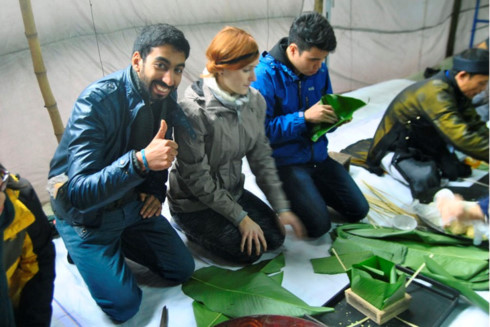 For almost every Vietnamese person, the traditional lunar New Year is an occasion for family reunion. Foreigners married to Vietnamese people also understand the importance of this occasion to their partners. This year, Pierre Bourndain of France has welcomed the 7th Tet in Vietnam with his wife Dang Thu Lan. Bourndain says he loves the relaxing moments of Hanoi during the first days of the lunar New Year when the streets are tranquil. He calls such experiences with his wife a simple happiness. “There’s a lot of praying, visits to the temple. I like the traditional way, and I like spending time with my Vietnamese relatives. We’re staying a few days in Hanoi to visit the family, the relatives, to go to different houses, to bring the “li xi” to the kids.”, said Bourndain. Bourndain’s wife, Thu Lan, was born in a traditional family in Hanoi and thanks to this, the French man has learned a lot about the Tet customs and celebrations. Bourdain says he is excited to go shopping ahead of Tet, to receive lucky money from older people, and to cook both Vietnamese and European food for their family and friends on the occasion. “We’d like to gather our friends in our home. We’ll welcome a lot of people, the family, the kids. We’re gonna share good meals and have a very good time. It’s a very nice mix between foreign cultures for traditional Vietnamese celebrations for Tet festival”, said Bourndain. Foreigners try making Vietnamese "Banh chung" or square sticky rice cakes for Tet Married to a Vietnamese girl three years ago, Richard Woody of the United Kingdom has welcomed 8 lunar New Years in Vietnam. Before getting married, Woody visited Vietnam every year to experience the Vietnam’s Tet atmosphere. “What do I like about Tet. I suppose it’s a good time of the year to see the family I’m married to. My wife is Vietnamese and to spend time with her family is really nice. We all come together. In England, that’s not very common anymore. And then of course I like eating. The food is just fantastic," said Woody. Aphisat is a Laotian studying in Vietnam. Aphisat says he enjoys Tet celebrations in Vietnam for their rich and diverse cultural values. "For me, Vietnam’s traditional lunar New Year celebrations are very meaningful and enjoyable. I was taught to make Vietnam’s square glutinous cakes by my teachers which is not easy but really fun. My friends and I gathered around a fire to boil the cakes in a very big pot. I had amazing experiences during the Lunar New Year’s Eve. I enjoyed it a lot with my friends during the first days of the New Year when we were given best wishes from our dear teachers, went to pagodas together to pray for the best luck in the New Year," said Aphisat. VOV |
↧
Article 0
↧
Article 1
Digital economy is the future for Vietnam Nhan Dan newspaper talked to some Vietnamese experts about the advantages of the digital economy in the course of applying the fourth industrial revolution. Nguyen Ba An, secretary general of the National Council for Sustainable Development and Competitiveness Improvement  At present many countries in the region have carried out their digital strategy including Viet Nam. But China and Singapore are the two leading nations. In our country, an e-Government system was launched several years ago, but the national system still needs further improvements. More recently, Prime Minister Nguyen Xuan Phuc signed a decree on advancing the campaign to bring Industry 4.0 to life. But I’m sorry to say there remain many things to be done. When we talk about the digital economy, for many Vietnamese, that economy seems alien. But in real life, the internet of things has penetrated all corners of our socio-economic life. The foundation for digital transformation is the data, but I have to admit our current data system is still weak. Electronic data of Government agencies at present simply focus on the State management performance of each agency, not on sharing information. This leads to waste of finances and human resources. It is time for us to improve the operational quality of all public agencies. To achieve this goal, we need to change our current thinking and adopt a suitable management method. That means we need to improve the efficiency and effectiveness of online public services for people and enterprises. Last but not least, the application of technology must go hand in hand with administrative reform and the development of online public services. Dang Kim Son, agricultural expert 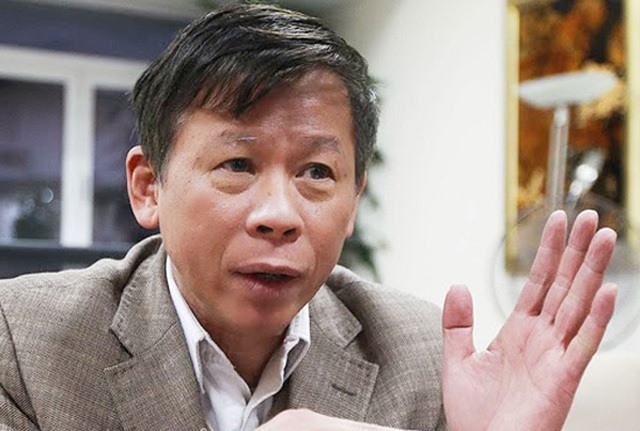 In my opinion, the most important thing in the course of digitalisation is the effectiveness of information sharing. To my knowledge, a digital economy is closely associated with informatics, automation and cloud computing, the internet and others. In the field of agriculture, digitalisation is used in remote control or automation. That’s why when we want to apply digitalisation in our agriculture industry we should start from need assessments. But, in my opinion, it is too early for us to talk about the application of digitalisation in agriculture with a very simple reason: we have not completed the mechanisation revolution while we have abundant labourers in the field of agriculture. It is indisputable that we need a very good foundation for information technology in an advanced agriculture coupled by the farmers’ strong knowledge and skills. But, I’m sorry to say that at present we’re facing a lot of difficulties in our basic infrastructure. So, in my opinion, the most challenging area that Viet Nam faces is digitalisation in our primary industry – agriculture. No doubt, when Industry 4.0 is applied to agriculture, it means manual work will be replaced by machines. As a result many people will be out of work. This is a big challenge for Viet Nam. And Viet Nam has to change its growth model. Agriculture must be then closely associated with industry, as is the countryside and towns and cities. What’s more important is the change of the cluster growth model toward the goal of harmonisation and opportunities for everyone. Lai Viet Anh, deputy director of the Department of E-Commerce and Digital Economy, under the Ministry of Industry and Trade 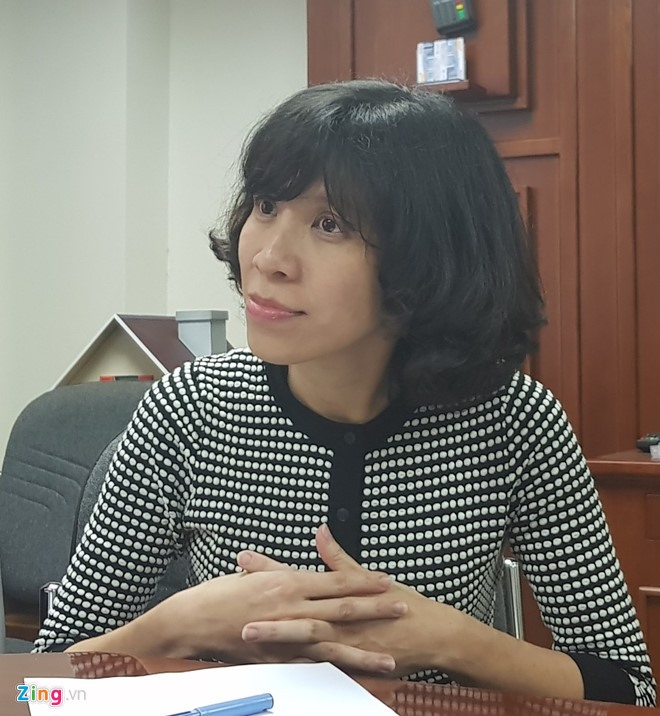 E-commerce is based on technology and the internet. Many new models of e-commerce have appeared with the participation of people from all walks of life. These new models have required a change in the management ideology and the current management mechanisms. In addition, e-commerce and the digital economy have required the creation of new national financial payment systems – e-payment and others. In this course of change, in my opinion, the State should give support to enterprises to help them become digital enterprises or adopt new business models which are all based on the new technology. Nguyen Thi Cuc, chairwoman of the Tax Consultation Association  It is indisputable that e-commerce is very transparent and all payment settlement must go through banks and middle agencies. That’s why, if we want to check or monitor the tax collection activities, the first thing we have to do is to review all the web sites, particularly big web sites to see their transactions. Through these e-transactions we’ll have the information we want between the sellers and buyers. In addition, the cost of e-business transactions is much cheaper that the traditional methods. For example, HCM City has recently saved some VNĐ9 billion (US$398,000) from taxes through e-transactions. It is indisputable: in the digital era, producers and business people have all acknowledged the novel importance of e-commerce. VNS |
↧
↧
Article 0
One day at Muong Culture Space Museum The Muong Culture Space Museum is located in a small limestone valley in Hoa Binh city, about 70km from Hanoi. 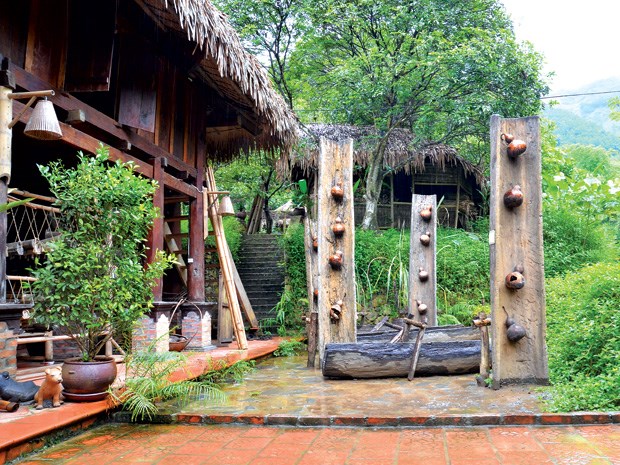 A corner of the museum Forgetting the busy daily life, we went to this place to see why many people leave noisy urban areas to come here at weekends or holidays to live in a peaceful environment close to the life of Muong people. Not at all dry as the image that the name “museum” often suggests, visitors to the place will find themselves in a lively space close to the nature. The 5ha Muong Culture Space Museum, established in 2007, is covered by the green of Wedelia chinensis plants. The plant’s small yellow flowers, which are in blossom the whole year, especially in spring, line the small paths, creating a poetic scenery. The museum’s staff also use these flowers to decorate reception desks and the lounge, giving visitors a fresh and relax atmosphere. Welcoming us were the museum’s staff and guides who looked graceful in Muong women’s traditional costumes, along with painter Vu Duc Hieu who devoted his youth and assets to study and establish the Muong Culture Space Museum. Hieu gave us the first impression of a man of few words with melancholy eyes. Though he is called Hieu “Muong”, Hieu is actually of the majority Kinh ethnic group and born in Hanoi. In 2000, he graduated the Hanoi Industry University in the glass technology major. He has a strong attachment to Hoa Binh as he grew up in the province and is engulfed by the unique Muong culture. The Muong Culture Space Museum is divided into two areas: one for reproductions and the other for display. Currently, the museum is preserving about 3,000 objects and many valuable books on Muong culture. Hieu spent 10 years collecting these exhibits. The museum is built as a miniature of the Muong society with four stilt houses corresponding to four different social strata. The first place to visit is the Lang house, demonstrating the life of the landlord class. After the Lang house is the Au house of the Lang’s servants, the Noc house of the commoners, and then the Noc Troi house of the lowest class in the Muong society. The Muong Culture Space Museum attracts a lot of domestic and foreign visitors. Our journey through both the reproduction and display areas at the museum ended at sunset. A dinner with typical dishes of the Muong was ready for us to enjoy. This was also an attraction for tourists when visiting the museum, where they can not only learn about the Muong culture but also enjoy Muong dishes and sleep in stilt houses, which makes the place ideal for a short holiday or on weekends. Visitors, especially those coming here for the first time, are sure to be impressed by such dishes as steamed forest vegetables, grilled fish, hot steamed glutinous rice and Muong wine. If you are lucky to come in the right season, there are some unique specialties such as ant egg or bee larvae. We will definitely come back to the museum to enjoy the environment and cuisine of the Muong people again. VNA |
↧
Article 2
Vietnam’s UNESCO-recognised intangible cultural heritages Vietnam boasts a wide range of intangible cultural heritages recognised by UNESCO. 1. Nha Nhac - Vietnamese court music 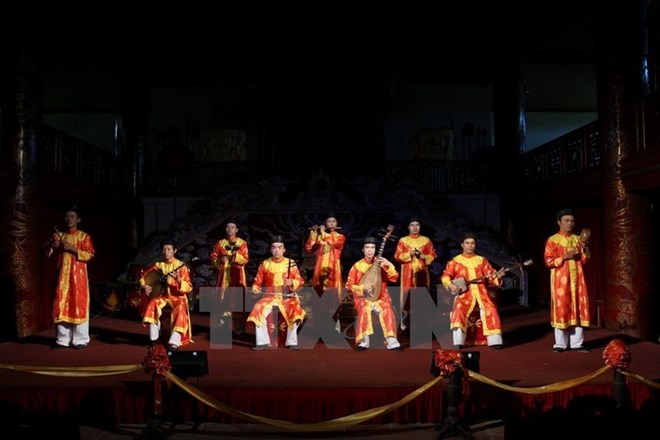 Nha nhac, Vietnamese court music, is named in the Representative List of the Intangible Cultural Heritage of Humanity Inscribed in 2008 on the Representative List of the Intangible Cultural Heritage of Humanity (originally proclaimed in 2003), Nha Nhac, meaning “elegant music” refers to a broad range of musical and dance styles performed at the Vietnamese royal court from the 15th to the mid-20th century. Nha Nhac was generally featured at the opening and closing of ceremonies associated with anniversaries, religious holidays, coronations, funerals and official receptions. Among the numerous musical genres that developed in Vietnam, only Nha Nhac can claim a nationwide scope and strong links with the traditions of other East Asian countries. Nha Nhac performances formerly featured numerous singers, dancers and musicians dressed in sumptuous costumes. Large-scale orchestras included a prominent drum section and many other types of percussion instruments as well as a variety of wind and string instruments. All performers had to maintain a high level of concentration since they were expected to follow each step of the ritual meticulously. Nha Nhac developed during the Le dynasty (1427-1788) and became highly institutionalised and codified under the Nguyen monarchs (1802-1945). As a symbol of the dynasty’s power and longevity, Nha Nhac became an essential part of the court’s ceremonies. However, the role of Nha Nhac was not limited to musical accompaniment for court rituals: it also provided a means of communicating with and paying tribute to the gods and kings as well as transmitting knowledge about nature and the universe. Certain forms of Nha Nhac have been maintained in popular rituals and religious ceremonies and serve as a source of inspiration for contemporary Vietnamese music. 2. Space of gong culture 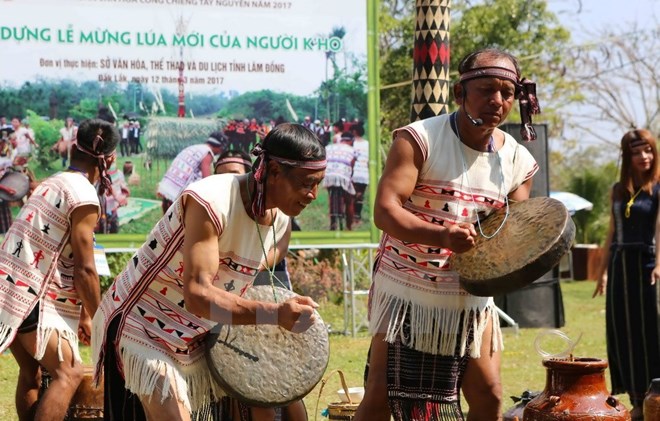 The cultural space of the gongs in the Central Highlands of Vietnam Inscribed in 2008 on the Representative List of the Intangible Cultural Heritage of Humanity (originally proclaimed in 2005), the cultural space of the gongs in the Central Highlands of Vietnam is closely linked to the daily life of local people. Their belief systems form a mystical world where the gongs produce a privileged language between men, divinities and the supernatural world. Behind every gong hides a god or goddess. Every family possesses at least one gong, which indicates the family’s wealth, authority and prestige. While a range of brass instruments is used in the various ceremonies, the gong alone is present in all the rituals of community life. Each instrumentalist carries a different gong measuring between 25 and 80 cm in diameter. From three to twelve gongs are played by the village ensembles, which are made up of men or women. Different arrangements and rhythms are adapted to the context of the ceremony, for example, the ritual sacrifice of the bullocks, the blessing of the rice or mourning rites. 3. Quan ho Bac Ninh folk songs 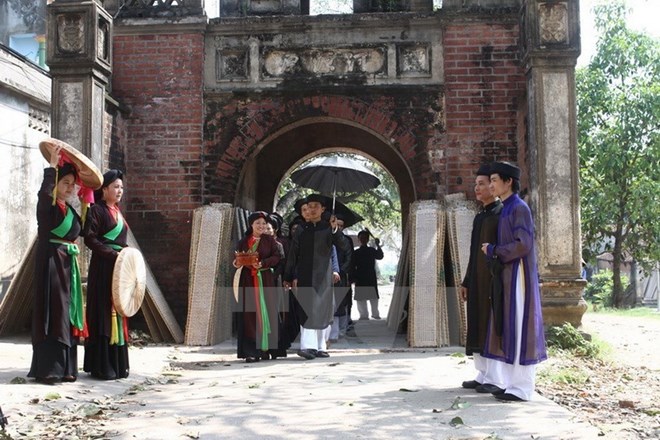 Quan ho Bac Ninh folk songs is part of the intangible cultural heritage of humanity Inscribed in 2009 on the Representative List of the Intangible Cultural Heritage of Humanity, the Quan ho Bac Ninh folk songs are performed as alternating verses between two women from one village who sing in harmony, and two men from another village who respond with similar melodies, but with different lyrics. The women traditionally wear distinctive large round hats and scarves; the men’s costumes include turbans, umbrellas and tunics. The song lyrics express people’s emotional states of longing and sadness upon separation and the happiness of the meeting of lovers. Quan ho singing is common at rituals, festivals, competitions and informal gatherings, where guests will perform a variety of verses for their hosts before singing farewell. Younger musicians of both sexes may practice the four singing techniques – restrained, resonant, ringing and staccato – at parties organised around singing. Quan ho songs demonstrate the spirit, philosophy and local identity of the communities in this region, and help forge social bonds within and between villages that share a cherished cultural practice. 4. Ca Tru singing  Ca tru singing is in the List of Intagible Cultural Heirtage in Need of Urgent Safeguarding Inscribed in 2009 on the List of Intangible Cultural Heritage in Need of Urgent Safeguarding, Ca tru is a complex form of sung poetry found in the north of Vietnam using lyrics written in traditional Vietnamese poetic forms. Ca tru groups comprise three performers: a female singer who uses breathing techniques and vibrato to create unique ornamented sounds, while playing the clappers or striking a wooden box, and two instrumentalists who produce the deep tone of a three-stringed lute and the strong sounds of a praise drum. Some Ca tru performances also include dance. The varied forms of Ca tru fulfill different social purposes, including worship singing, singing for entertainment, singing in royal palaces and competitive singing. Ca tru has 56 different musical forms or melodies, each of which is called “the cach”. Folk artists transmit the music and poems that comprise Ca tru pieces by oral and technical transmission, formerly, within their family line, but now to any who wish to learn. 5. Giong festival of Phu Dong and Soc temples 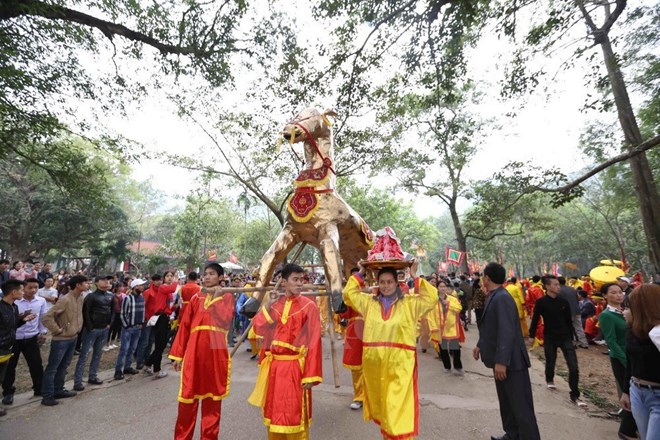 Giong Festival of Phu Dong and Soc temples was named part of intangible cultural heritage of humanity in 2010 Inscribed in 2010 on the Representative List of the Intangible Cultural Heritage of Humanity, the Giong festival of Phu Dong and Soc temples is celebrated annually in outlying districts of Hanoi, the capital of Vietnam. Each spring, before the rice harvest, Vietnamese people honour the mythical hero, god and saint, Thanh Giong, who is credited with defending the country from foreign enemies, and is worshipped as the patron god of the harvest, national peace and family prosperity. The festival at Phu Dong temple, which takes place in the fourth lunar month in the village of his birth, symbolically re-enacts his feats through the riding of a white horse into battle and the orchestration of an elaborate flag dance to symbolise the battle itself. Young men receive extensive training to play the roles of Flag Master, Drum Master, Gong Master, Army Master and Children’s Master, while 28 girls aged 9 to 13 are selected to play the enemy generals. The Flag Master’s dancing movements and drum and gong sounds convey the development of the battle, and paper butterflies released from the flag symbolically disperse the invaders. The arrival of rains after the festival is seen as a blessing from the saint for an abundant harvest. The celebrations at Soc temple, where Saint Giong ascended to heaven, take place in the first lunar month and include the ritual of bathing his statue and a procession of bamboo flowers to the temple as offerings to the saint. 6. Xoan singing of Phu Tho province 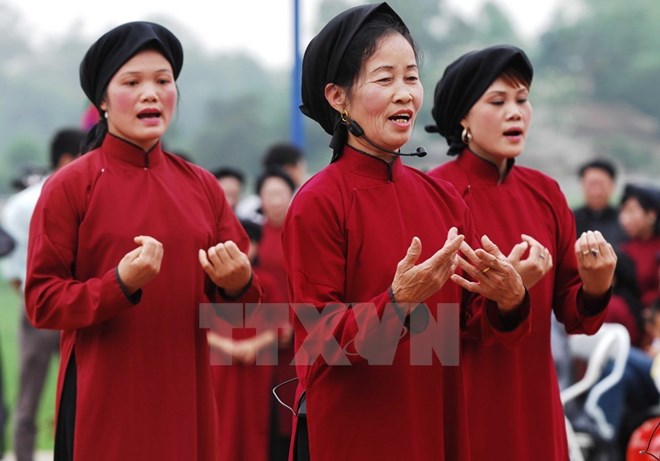 Xoan singing of Phu Tho province is on the Representative List of the Intangible Cultural Heritage of Humanity Inscribed in 2017 on the Representative List of the Intangible Cultural Heritage of Humanity, Xoan singing in the northern province of Phu Tho includes singing, dancing, drumming and clapper beating. It is closely linked to the worship of the Hung Kings, a belief rooted in the ancestor worship practice of Vietnamese people. Bearers and practitioners form four guilds, in which the male and female “Trum” play the most important role: they preserve the songs, select students, transmit the singing styles and repertoires and organise practices. They are also active in introducing and teaching Xoan singing in clubs and guilds. As a community performing art, Xoan singing fosters cultural understanding, community cohesion and mutual respect. The Vietnamese Institute for Musicology has collected 31 Xoan songs, and thanks to the efforts of several Xoan artists, four guilds have been established. Thirty-three dedicated clubs also exist, and seminars are held to expand the knowledge of Xoan. Senior Xoan artists transmit the singing orally, combined with the use of written songs and audio and visual recordings. 7. Worship of Hung Kings in Phu Tho  The worship of Hung Kings in Phu Tho province recognised as a UNESCO Intangible Cultural Heritage of Humanity in 2012 Inscribed in 2012 on the Representative List of the Intangible Cultural Heritage of Humanity, the worship of Hung Kings in the northern province of Phu Tho draws millions of people annually to commemorate their ancestors and pray for good weather, abundant harvests, good luck and good health. The largest ceremony, the ancestral anniversary festival of the Hing Kings, is celebrated for about one week at the beginning of the third lunar month. People from surrounding villages dress in splendid costumes and compete to provide the best palanquin and most highly valued objects of worship for the key rite in which drums and gongs are conveyed to the main temple site. Communities make offerings of rice-based delicacies such as square cakes and glutinous cakes, and there are verbal and folk arts performances, bronze drum beating, Xoan singing, prayers and petitions. 8. Art of Don ca tai tu music and song in southern Vietnam 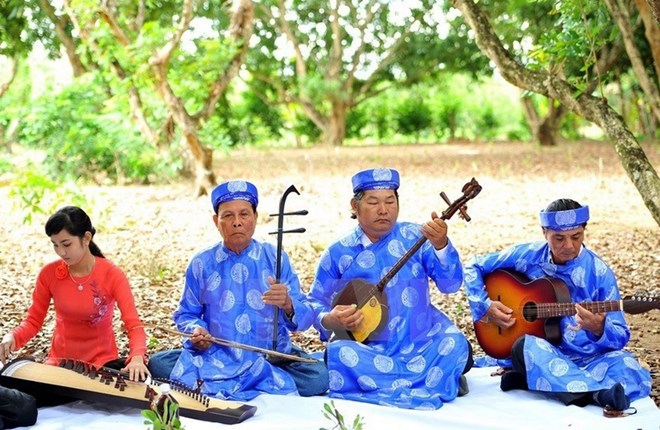 The art of Don ca tai tu music and song in southern Vietnam was named in the list of intangible cultural heirtage of humanity in 2013 Inscribed in 2013 on the Representative List of the Intangible Cultural Heritage of Humanity, the art of “Don ca tai tu” music and song is an indispensable part of the spiritual activity and cultural heritage of people in the south of Vietnam. The music and songs evoke the people’s life and work on the land and rivers of the Mekong Delta region. Performed at numerous events such as festivals, death anniversary rituals and celebrations, “Don ca tai tu” is thus intimately connected with other cultural practices and customs, oral traditions and handicrafts. Performers express their feelings by improvising, ornamenting and varying the skeletal melody and main rhythmic patterns of these pieces. “Don ca tai tu” is played on a variety of different instruments, including the moon-shaped lute, two-stringed fiddle, sixteen-stringed zither, pear-shaped lute, percussion, monochord and bamboo flute. Its repertoire is based on twenty principal songs and seventy-two classical songs. The musical art is passed on through oral transmission, based on imitation, from master instrumentalists and singers to students. Musicians need to study for at least three years to learn the basic instrumental techniques and master the musical modes to express different moods and emotions. Vocal students study the traditional songs and learn to improvise subtly, using different ornamentation techniques. 9. Vi and Giam folk songs of Nghe Tinh 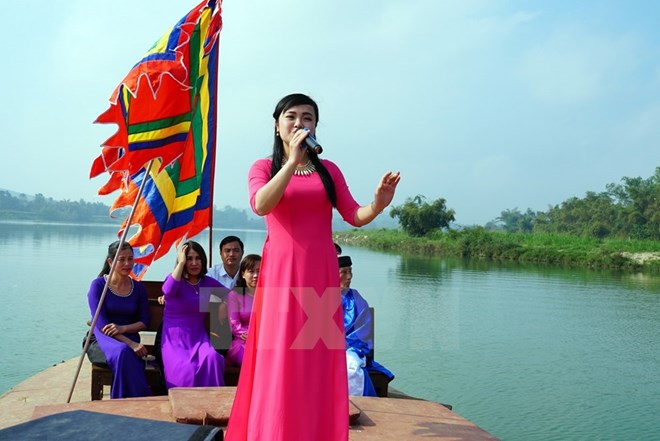 Vi and Giam folk songs of Nghe Tinh are on the Representative List of the Intangible Cultural Heritage of Humanity Inscribed in 2014 on the Representative List of the Intangible Cultural Heritage of Humanity, Vi and Giam songs are sung by a wide range of communities in the north-central provinces of Nghe An and Ha Tinh. Specific songs are sung without instrumental accompaniment while people cultivate rice in the fields, row boats, make conical hats or lull children to sleep. Vi and Giam lyrics use the specific dialect and linguistic idioms of the Nghe Tinh region and practitioners sing with the particular singing voice of local people. Many of the songs focus on key values and virtues including respect for parents, loyalty, care and devotion, the importance of honesty and a good heart in the maintenance of village customs and traditions. Singing provides people with a chance to ease hardship while working, to relieve sorrow in their lives, express feelings of sentiment between men and women, and exchange feelings of love between unmarried boys and girls. Today Vi and Giam are commonly performed at community cultural events and are sung by artists in theatres. 10. Tugging rituals and games Inscribed in 2015 on the Representative List of the Intangible Cultural Heritage of Humanity, tugging rituals and games in the rice-farming cultures of East Asia and Southeast Asia are enacted among communities to ensure abundant harvests and prosperity. They promote social solidarity, provide entertainment and mark the start of a new agricultural cycle. Many tugging rituals and games also have profound religious significance. Most variations include two teams, each of which pulls one end of a rope attempting to tug it from the other. The intentionally uncompetitive nature of the event removes the emphasis on winning or losing, affirming that these traditions are performed to promote the well-being of the community, and reminding members of the importance of cooperation. Many tugging games bear the traces of agricultural rituals, symbolising the strength of natural forces, such as the sun and rain while also incorporating mythological elements or purification rites. Tugging rituals and games are often organised in front of a village’s communal house or shrine, preceded by commemorative rites to local protective deities. Village elders play active roles in leading and organising younger people in playing the game and holding accompanying rituals. They also serve to strengthen unity and solidarity and sense of belonging and identity among community members. 11. Practices related to Vietnamese beliefs in the Mother Goddesses of Three Realms  The practices related to the Viet beliefs in the Mother Goddesses of Three Realms are on the Representative List of the Intangible Cultural Heritage of Humanity Inscribed in 2016 on the Representative List of the Intangible Cultural Heritage of Humanity, the practices in the Mother Goddesses of Three Realms (heaven, water, and mountains and forests) aim to meet spiritual needs and everyday wishes of Vietnamese people. The Mother Goddesses include Lieu Hanh (a nymph who descended to earth, lived as a human and became a Buddhist nun) referred to as the Mother of the World, and other spirits considered legendary heroes. The traditional practice involves daily worship and participation in ceremonies, rituals like the spirit possession ritual and festivals such as Phu Day that take place at temples dedicated to the Mother Goddesses. These activities associated with the practice help to maintain part of the community’s history, cultural heritage and identity with some aspects incorporating traditional costumes, music and dance. Bearers and practitioners are members of the public, temple guardians, ritual priests, spirit mediums, assistants and musicians who transmit knowledge and skills orally to newcomers and family members. The practice of shared values and strong beliefs in the compassion and grace of the Mother Goddesses provides a basis for social relations connecting members of participating communities. The worshipping of the Mother Goddesses also contributes to the appreciation of women and their roles in society. 12. The art of Bai Choi in central Vietnam 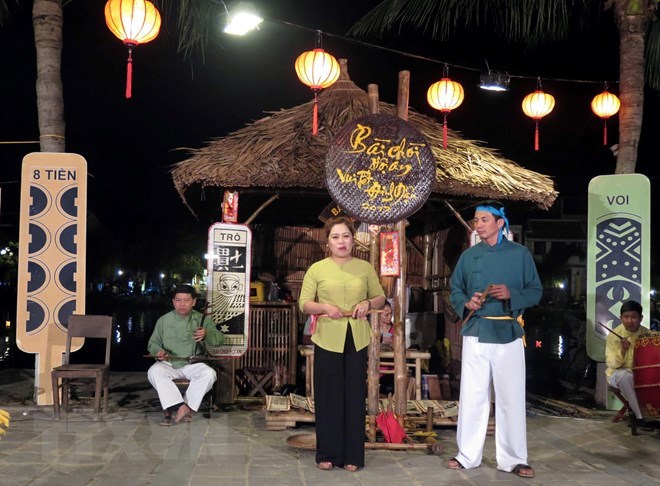 The art of Bai Choi in central Vietnam is a diverse art combining music, poetry, acting, painting and literature Inscribed in 2017 on the Representative List of the Intangible Cultural Heritage of Humanity, the art of Bai Choi in central Vietnam is a diverse art combining music, poetry, acting, painting and literature. It takes two main forms: Bai Choi games and Bai Choi performance. Bai Choi games involve a card game played in bamboo huts during the Lunar New Year. In Bai Choi performances, male and female artists perform on a rattan mat, either moving from place to place or in private occasions for families. The art of Bai Choi is an important form of culture and recreation within village communities. Performers and their families play a major role in safeguarding the practice by teaching song repertoires, singing skills, performance techniques and card-making methods to younger generations. Together with communities, these performers have set up nearly 90 Bai Choi teams, groups and clubs to practise and transmit the art form, which attracts wide community participation. Most performers of the art learn their skills within the family and the skills are mainly transmitted orally, but artists specialising in Bai Choi also transmit knowledge and skills in clubs, schools and associations. VNA |
↧
Article 1
Even a short absence is revealing in VietnamOne of the most interesting aspects of my lifestyle is that I never get in a rut or bored in any one place, getting a fresh new perspective with each trip  Cold Saigon beer, goat meat, and 'chao,' what else would you ask for? I’ve spent the past 5 years living a nomadic lifestyle, wandering from one destination to another in my 6 favourite countries in Southeast Asia. For this past Western holiday month of December, I visited my beloved Borneo, a part of Malaysia which is a rich tapestry of many indigenous groups and religions who bond together to celebrate each group’s big holidays including Christmas. One of the most interesting aspects of my lifestyle is that I never get in a rut or bored in any one place, getting a fresh new perspective with each trip. Usually I’ll spend a month or two in one spot, although my trips to Vietnam have become longer as I fall in love with it more each passing year. Moving from one destination to another presents no culture shock feeling because I’ve been doing it so long, so each time I arrive at one of my destinations it’s more like a homecoming. But this past time, after only 5 short weeks, I was blown away by many things when I came back to Vietnam. My return early January started with a bang before I even technically arrived! The pace of life in Ho Chi Minh City is very fast as in any megacity, so it was a shock after sleepy Borneo, which moves forward very slowly. The action in Vietnam started even before the airplane arrived at its parking place. After landing, the aircraft merged onto one of the taxiways headed for the terminal and some people got up, removed their belongings from the overhead compartments and started heading for the front to exit the airplane. They weaved drunkenly to and fro as the airplane took several turns on the way to our gate. The Malaysian crew was having a fit - gesturing and yelling for everyone to sit down, but they were ignored by all. The crew knew it was a losing battle, so they just sulked in their jump seats at the front of the airplane. It’s Vietnam, people have things to do and places to go, so quite a few passengers followed suit until there was a queue near the front door of the airplane when we arrived at the gate. There were enough people in and outside the Arrival Hall to fill a football stadium, many holding signs with foreign names on them for pick-up and delivery to the city center. This place sure is becoming popular! I usually transit through overnight staying near the airport not wanting to fight the traffic, but the fact is it’s so busy that crossing the street on foot is a challenge. The traffic is like a version of bumper cars we played at the fairs when I was a kid, except in this version people head straight for each other then veer away to avoid collisions at the last moment instead of trying to hit each other. The trick for a pedestrian is to carefully pick a spot to cross, then stick to it, moving predictably through the endless stream of motorbikes, never varying cadence or route, letting the motorbikes swerve out of the way instead of trying to navigate through them. Tip: Keep staring straight ahead no matter what! Works well - at least to date I have not been squished by a motorbike. Along the street that houses my favourite hotel, familiar faces offered little waves and nods - the security guy across the street, the young man working in the convenience store, the hotel motorbike valet, and the sandwich girl on the corner. They all remember me - I guess not many foreigners drag their belongings down the street, most preferring cool, comfortable taxis. There aren’t many Westerners at all in the neighbourhood surrounding Tan Son Nhat International Airport - they zip off to the action in the city center. Not me - I love the feel of that neighbourhood, warm and friendly, and delightfully informal. Of course the reception girl had everything organized, true to form. She knew which floor and room would be just right, organized the bill, and off I went to my room in no time flat. At the end of the afternoon, I headed down the street to visit the Goat Gang who runs a delightful beer garden that serves only goat. But those darned accents! I’ll never master them. I saw “de” on several signs and it confused me because it can mean several things. Finally after a few trips I caught on to “con dê” (goat). Nobody in the Goat Gang speaks more than a few words of English, so they must have got together and worked on the menu: “We serve ONLY GOAT! No chicken, seafood, or beef! You eat GOAT here! ONLY GOAT HERE!” is marked all over the menu in huge letters. I get the feeling that their message eliminates a lot of foreigners from the equation, but not me. I was thrilled to be there and couldn’t wait to get into that goat. Indeed, I had a serious case of food sickness while absent. I don’t mean sickness of the intestinal variety - more of a homesickness for Vietnamese food. Honestly, I was counting the days until my return to the Land of Food and I wasn’t disappointed. The Goat Gang has curries, barbecues, hot pots, shabu shabu - all sorts of variations. I go for the “sa té” nearly every time, washing it down with a few beers. This is not the average run-of-the-mill “sa té” by any means. All over Asia you can find something similar - a stir-fry with various vegetables spiked with cilantro and mild chilli peppers. Maybe toss in some noodles and a plum sauce and that’s about it in most countries.
But the Vietnamese goat is always spiked with “chao” - a version of fermented tofu serving as an accompanying dip/sauce that truly makes the dish. The chao is served with a nice dollop of homemade garlic chilli sauce, the two are then combined to create an unforgettable texture and flavour. Pungent, rich, salty, and with a nice little spicy kick thanks to the chilli sauce. And that one little thing symbolizes the Vietnamese approach to food: dabbling with various ingredients and methods, using hybrid international solutions where needed, and finally coming up with a game-breaker like that chao. The Goat Gang remembers me because I’m always slobbering over their food and able to order my meal in Vietnamese with a small degree of competence. Fair enough, not a lot of skill needed to say “sa té” and “chai bia lanh” (a bottle of cold beer). Not much, but at least it elevates me to a status slightly above transiting tourist. They giggle among themselves and whisper comments about how I approach the feast. They also wonder what I’m up to because I always take photos and make notes. Who makes notes about goat? I do. Little do they know what I’m really up to, and I won’t be telling. The young man assigned to me brings a chilled beer and tosses a few more into the ice cooler nearby (Vietnamese are always switched on). He knows I don’t favour the “room-temperature-served-with-an-ice-cube approach.” Upon arrival back in my room I wrote the hotel I stay at in Da Lat to ask that she send a taxi to pick me up at the airport the next day. I provided the flight number and arrival time, then asked for confirmation, which I miraculously received before I even sent the message! That’s Phuong, the owner, she never skips a beat either - she knew I’d want her boomerang back to be sure we were in perfect synch, so she confirmed immediately. All the above action sure was a shock to the system for the first 24 hours, and, while there is no denying this country is still inching forward in the development cycle, there is an air of urgency, energy, efficiency, and optimism unlike anywhere else I go. We lose sight of things near to us after a while, so it’s good to travel and take a break for a bit. After all the countries and destinations I’ve learned that even a short absence reveals a lot, makes me appreciate things even more, like that unforgettable “chao” at the goat joint near Tan Son Nhat. By Rick Ellis / Tuoi Tre News Contributor |
↧
↧
Article 0
Locals still struggle with adapting to Industry 4.0The Fourth Industrial Revolution has become a buzzword in Vietnam, but locals rarely regard it as a technology that helps them make more money online and improve their daily lives. What many are most concerned about is that they could lose their jobs, as robots might be capable of handling the position they are in.
Farmer Nguyen Thi Hue has been making a living by planting banana trees under Long Bien bridge in Hanoi for the past two decades. Her daily work is to take care of the banana orchard and harvest bananas for sale at the end of the day. She is fond of surfing the internet on her five-inch Asus smartphone. She is also a Facebook user, with an account opened for her by her nephew. Instead of enjoying the South Korean films she used to love, Hue is now keen on logging into her Facebook account in order to read the posts of joy, anger, and love from her children, nephews, and relatives. Such posts make her smile and, on occasion, tear up. That is why she prefers Facebook. Aside from going online, she often joins in idle talk with her friends, including vendors selling iced tea on Long Bien bridge and workers doing repairs on the historical bridge. It seems that the Fourth Industrial Revolution or Industry 4.0 has yet to affect Hue and her friends. They just own a smartphone to take selfies and souvenir photos for their relatives, and then share them on their Facebook accounts. They do not know what deep impacts Industry 4.0 has on the world economy. A lot of industries have seen fundamental changes with newly-emerged business models. Cutting-edge technologies enable startups to gain advantages over those using now-obsolete solutions. They cannot make sense of the cloud, driverless automobiles, robots, and cryptocurrencies like bitcoin. In their eyes, cutting-edge technology is associated with the appearance of Grab and Uber drivers in green and blue clothes. “Grab and Uber bikers work just like traditional motorbike taxi drivers who normally cool off their heels here, but they look somewhat posh in their uniforms,” says Hue. 26-year-old Phan Phuong Duc, a maths teacher at the combined primary and secondary Ngoi Sao Hanoi School, is not well-grounded in Industry 4.0 either. He felt the changes in technology when his colleagues began to use powerpoint presentations in their lectures instead of writing on the blackboard. But working as an online tutor with the mobile app GotIt! has enabled him to ‘touch’ technology and change his life over the past two years. The app was designed by Tran Viet Hung in the US tech capital Silicon Valley. Duc graduated from the University of Science under the Hanoi-based Vietnam National University. He studied maths in English. Working for the online app helps him reinforce his knowledge in maths and English. Duc maintains a tutorship to earn $100 per month. According to founder and CEO Tran Viet Hung, Vietnam now has some 300 Vietnamese experts registered for the GotIt! system. Like Uber and Grab apps, GotIt! brings potential job opportunities to hundreds of thousands of experts. Tens of thousands work very actively on the system, half of them reported making their main income from GotIt!. GotIt! inspires people all over the world to earn more money by sharing their knowledge on the system, regardless of where they are. Learning about technology platforms in Industry 4.0 costs Hue, Tuan, and others a lot of time and effort. Currently, not every Industry 4.0 platform can become useful in Vietnam. For instance, self-driving vehicles would become powerless in the face of heavy traffic congestions in Vietnam’s big cities. Miners seem to pay no attention to cloud computing services and the development of a sharing economy, while tailors are not concerned with how Industry 4.0 benefits the fast fashion boom. What they pay the most attention to is the risk of losing their jobs. Instead of thinking about the products they want to buy for the Lunar New Year or the destinations they want to visit, workers at Canon Vietnam in the northern province of Bac Ninh raised inconclusive discussions about the factory’s installation of new automated machines and robots for production. “We could lose our jobs,” Le Anh Tung, a Canon worker, said and turned his eyes to his two sleeping children. Both Tung and his wife work for Canon Vietnam. The couple plans to return to their hometown to open a small-scale business once the automated machines and robots take their current jobs. Canon Vietnam has been accelerating the automation process of its production in the past years. As a result, automation helped slash the firm’s total number of labourers from 13,000 recorded seven years ago to the existing figure of 8,000. Various positions and jobs are now being undertaken by robots. Canon Vietnam often purchases only specialised equipment, not expensive completely-built robots. Canon engineers then assemble the specialised equipment with others to create finished machines for production, thus helping to save on the total costs, a Canon Vietnam representative said. Apart from Canon, other firms, especially those in the sectors of garments, textiles, and footwear, are considering the installation of automated equipment and robots. As many as 86 per cent of workers in the sector of garments and textiles will be replaced by automated production lines and robots in the upcoming decades, according to a recent ILO report. In countries with an abun dant labour supply like Vietnam, technological applications could make a number of manual labourers jobless. In the wake of the movement of of applications and technologies toward Industry 4.0, Vietnam needs to set forth employee support policies in a timely manner, to aid those vulnerable to the adverse impacts of Industry 4.0. Running a small-scale business in the homeland is a final solution for Canon worker Tung. He now desires to benefit from Industry 4.0 by learning to improve his technical skills. “But where I can learn to better my skills remains a problem,” Tung said. Google Trends show that Industry 4.0 has become the most searched-for keyword in Vietnam in the recent past. It can be said that Industry 4.0 urges enterprises to think about ways to satisfy customer demand, better productivity and quality, reduce production costs, and further meet environmental requirements. For intellectuals, Industry 4.0 means a tool to enjoy a better and convenient life and ease their access to and information gathering on the internet. Technology is changing lives. This rings true, at least for Uber and Grab drivers. Technology not only changed their business, but also brought in a main source of income. Interestingly, Vietnam quickly acknowledged the value of applications like Uber and Grab and approved the pilot execution. This could help facilitate co-operation opportunities between local and foreign firms, while encouraging local technology startups to deal with social issues. GotIt! set a goal of establishing a system of thousands of experts, including tens of thousands from Vietnam, but it failed to reach the goal for Vietnam. Just 5 per cent of Vietnamese experts applying for jobs on GotIt! met the requirements. “It seems that local youths are not ready for Industry 4.0, while those in other countries are keen on the global trend thanks to their advantages in qualification, foreign language skills, and industriousness,” said the founder of GotIt!, elaborating that younger Vietnamese generations should not put high hopes on opportunities emerging from Industry 4.0. |
↧
Article 1
2017- a record year of FDI attraction 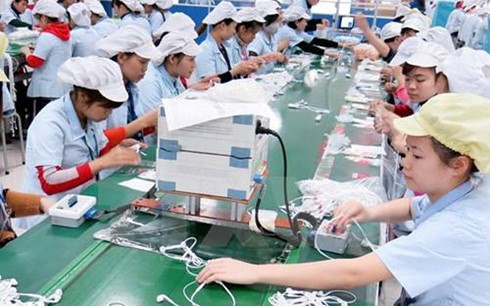 Last year foreign enterprises invested in 19 sectors with the processing and manufacturing industries attracting nearly US$16 billion, accounting for more than 44% of the total registered capital. Production, electricity distribution, and real estate drew a large amount of investment. Among 115 countries and territories investing in Investment environment - key to Do Nhat Hoang, Director of the Department of Foreign Investment at the Ministry of Planning and Investment said there were many reasons for the sharp rise of FDI in 2017 against a forecast of US$30 billion. The rise was reported on both registered and implemented capital. In the total of US$20 billion worth of implemented capital, US$17.5 billion was disbursed, up 7.5% against 2016. Last year foreign investors spent more than US$3 billion on buying shares. Hirohide Sagara, the Co-Chairman of the Vietnam Business Forum Alliance 2017, said, “I think current activities of the Vietnamese government can be valued highly. We’re glad to continue to work with the Vietnamese government.” Opportunity to attract FDI Despite regional instability, Robert Moritz, Global President of PricewaterhouseCoopers (PwC) said US President Donald Trump’s attendance at the APEC events last November in Da Nang created major opportunities for Vietnam and the US to boost investment cooperation. He said, “Just like every country in terms of areas for investment, you need to have a very strong domestic growth agenda. It has been proved over the past years in According to VOV5 |
↧
Article 0
Permanent office of UXO steering committee set up Prime Minister Nguyen Xuan Phuc, head of the National Steering Committee on the Settlement of Post-war Unexploded Ordnance and Toxic Chemical Consequences, has signed a decision to establish the committee’s permanent office. 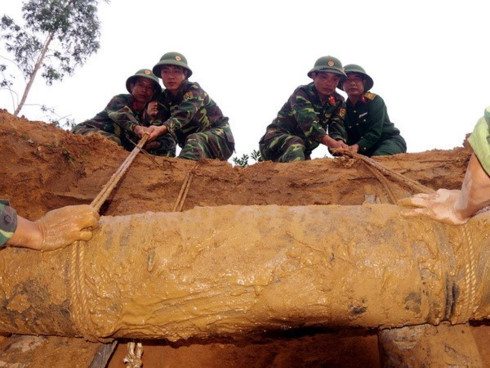 Soldiers discover post-war bomb Under the decision, Director of the office is the Deputy Minister of National Defence who is also permanent member of the steering committee. Its deputy directors include Deputy Ministers of Labour, Invalids and Social Affairs; Natural Resources and Environment; and Planning and Investment; a Deputy Chief of the General Staff of the Vietnam People’s Army (VPA), and a Deputy Director of the General Department of Politics of the VPA. The office is located in the Defence Ministry’s Department of Military Science. It is responsible for proposing orientations and solutions to important issues, and measures to mobilise domestic and foreign resources to quickly tackle post-war bomb and mine and toxic chemical consequences in Its duties are also to make long-term, medium-term and yearly plans to implement national action plans and programmes on the settlement of consequences; coordinate the work between ministries, ministry-level and offices, and local People’s Committees; and make regular and unscheduled reports on the work. VNA |
↧
Article 4
The Ministry of Labour, Invalids and Social Affairs (MoLISA) has set a target to send 110,000 labourers to work abroad in 2018, with 40 percent being women. 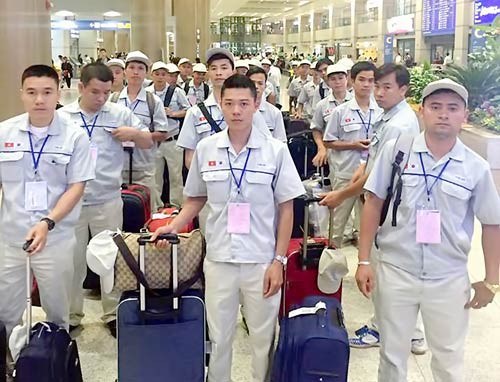 The Ministry of Labour, Invalids and Social Affairs (MoLISA) has set a target to send 110,000 labourers to work abroad in 2018. (Photo: nld.com.vn) The ministry will try to maintain traditional labour markets like the MOLISA Deputy Minister Doan Mau Dieu said that the Department of Overseas Labour should study to make recommendations for the amendment of the law on Vietnamese workers working overseas under contracts while renewing inspection work. Solutions should be deployed to strictly manage and protect the interests of Vietnamese labourers working in foreign countries, he noted. Last year, over 134,700 workers went to work abroad, including 53,340 female workers. The figure exceeded the annual plan set for 2017 by 28.3 percent. This is also the fourth consecutive year that the number of workers sent overseas has surpassed the 100,000 benchmark. Other labour markets receiving large numbers of Vietnamese workers were the The results were attributable to the MoLISA’s efforts like organising a conference with 280 labour export enterprises to remove bottlenecks in the work and discuss measures to improve their operation efficiency and workers’ quality. Last year, the ministry granted licences for 44 more labour export companies and carried out inspections in 29 firms sending workers abroad in contracts. The inspection revealed violations of labour export regulations at 16 companies and five companies had their licenses revoked. Meanwhile, three others were ordered to suspend their operation for 6-9 months. VNA |
↧
↧
Article 3
Shares rally on investor optimism Vietnamese shares soared on February 21, the first trading day of the lunar year, thanks to positive sentiment among investors. 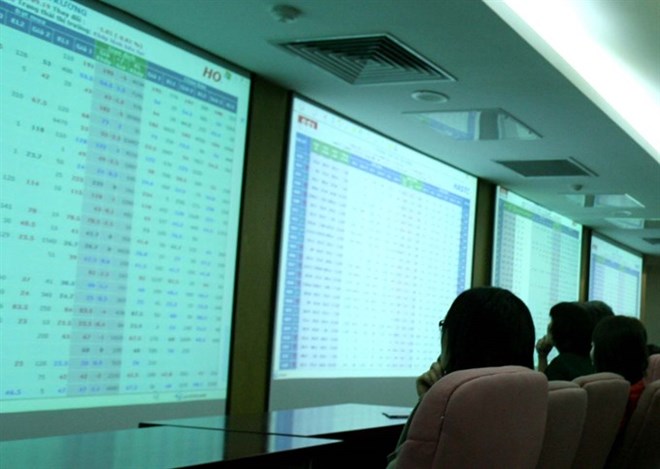 Investors follow transactions at Bao Viet Securities Company in The benchmark VN-Index on the HCM Stock Exchange climbed 2.59 percent to close the day at 1,087.15 points. It soared 1.7 percent during the last trading day of the lunar year (February 13), closing at 1,059.73 points. The HNX Index on the Hanoi Stock Exchange edged up 1.24 percent to end at 125.85 points. It edged up 1.88 percent to end at 124.31 points on February 13. The UPCOM Index on the Unlisted Public Company Market edged up 1.5 percent to stand at 59.37 points. It edged up 1.83 percent to finish at 58.50 points on February 13. More than 239.4 million shares, worth 6.84 trillion VND (300.7 million USD), were traded on February 21. The market trading condition was ruled by gaining stocks, which were dominant over decliners by 432 to 194, while 822 other stocks ended flat. The first trading session of the lunar year took place with a strong increase in banking stocks such as JSC Bank for Investment and Development of Vietnam(BID), up 5.7 percent; Bank for Foreign Trade of Vietnam (VCB), increasing 3.4 percent; Vietnam Joint Stock Commercial Bank for Industry and Trade (CTG), moving up 2.4 percent. Meanwhile, oil-gas stocks experienced a wide divergence and had more negative movement than the overall market as PetroVietnam Drilling & Well Services Corporation (PVD), PetroVietnam Technical Services Corporation (PVS) and Petroleum Equipment Assembly & Metal Structure .,JSC (PXS) tumbled. Large-cap stocks also had a good trading day as 24 of the 30 largest shares by market capitalisation advanced in the VN30 Index. The VN30 Index was up 2.81 percent to 1,034.76 points with more than 60 million shares exchanged, worth 3.03 trillion VND. Foreign investors saw a net sale of 48.3 billion VND on HOSE, focusing on Hoa Phat Group Joint Stock Company (194.2 billion VND), Ho Chi Minh Development Joint Stock Commercial Bank (25.2 billion VND) and Vincom Retail Joint Stock Company (21 billion VND). In addition, they sold a net 29.51 billion VND on the HNX. According to BIDV Securities Co (BSC), the market is in the uptrend and it is likely to surpass the old peak of 2007. “In the coming sessions when the cash flow returns, investors should consider good fundamental stocks with satisfactory Q1 results such as banking and real estate sectors,” BSC said in its daily report. Meanwhile, Bao Viet Securities Company (BVSC) said in its report that after the rally today, the market may turn balanced in next sessions. “The market may experience a divergence amid low liquidity on February 22,” BVSC said. VNA |
↧
Article 2
The government needs to take action to reduce the size of the informal economic sector, economists say. 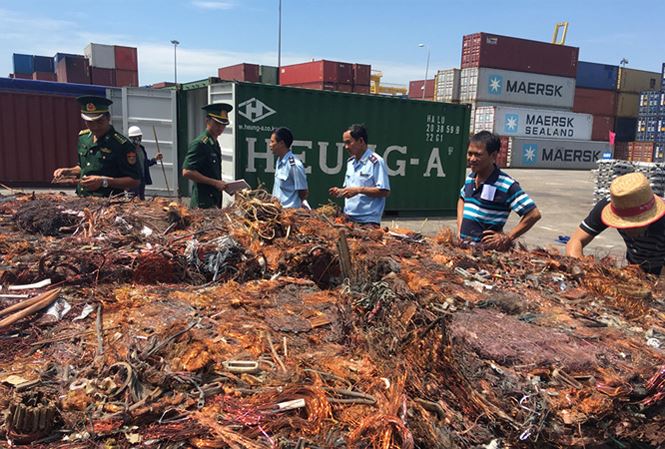 According to Luu Bich Ho, former head of the Research Institute for Development Strategies, the value of the informal economic sector is equal to roughly 30 percent of GDP. He said it is possible to measure the sector, but the accuracy of the figures and the purpose of the calculations are in doubt. “We can only collect tax on 5 percent of the 30 percent. This is because we still cannot observe and control the economic sector,” Ho said, admitting that measuring and controlling the sector is a difficult task. Asked about the factors which led to the increase in the size of the informal sector in
Under current regulations, all institutions and establishments must set up businesses and file registration with agencies when they have more than 10 workers. But in reality, many of them don’t. This explains why business households, though developing well, still cannot grow into businesses. An analyst commented that the business establishments run by households are not under the control of central agencies and are ‘protected’ by local authorities. The protection allows business households to evade tax. “We still cannot prove this and quantify it, but researchers believe this exists,” he said, adding that to be able to control the informal sector, it is necessary to strengthen the fight against corruption at local authorities. If the informal sector is ‘observable’ and the size of the sector can be measured, the value generated by the sector can be counted when calculating the nation’s GDP. If so, the current public debt would decrease from 64 percent to 61-62 percent. "To secure public debt, the economy needs to grow healthily, transparently, efficiently and the state needs to collect tax from business activities,” Ho said. “In other words, the government needs to take action so that the size of the informal sector decreases and becomes normal and pays tax,” he added. Meanwhile, Pham Chi Lan, an economist, commented that if counting the informal economic sector when calculating GDP, the public debt problem ‘may get even worse’. Lan agrees that the government needs to apply reasonable solutions to encourage the members of the informal sector to join the formal economic sector. Economists continue to argue about the size of the informal economic sector. While some economists say it is about 30 percent of GDP, the General Statistics Office disagrees. VNN/Chi Mai |
↧
Article 1
In |
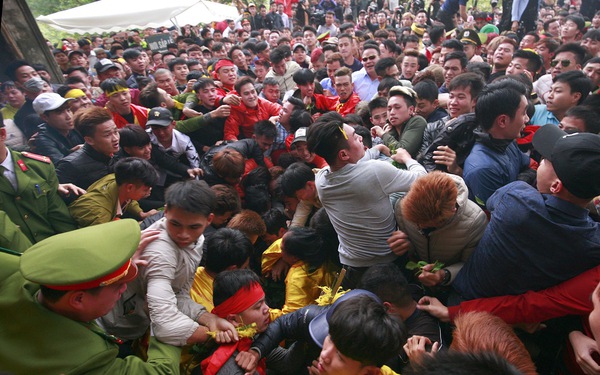 |
People jostle to participate in a Tet festival in northern |
In modern time, such a conception has become outdated as most salaried workers in Vietnam
The ‘syndrome’ is more or less the same as the so-called ‘Blue Monday,’ or the ‘most miserable day of the year’ that usually falls in January, in some Western countries.
The ‘Blue Monday’ is determined each year based on a series of factors such as weather, debt level, the amount of time since Christmas and New Year. It is believed that on that day, many are in depression over the money they spent for celebrations, their failure to achieve New Year's resolutions, or low motivational levels.
Some Vietnamese salaried workers, who started their Tet break early last week, would feel the same during their first working day after the holiday on Wednesday.
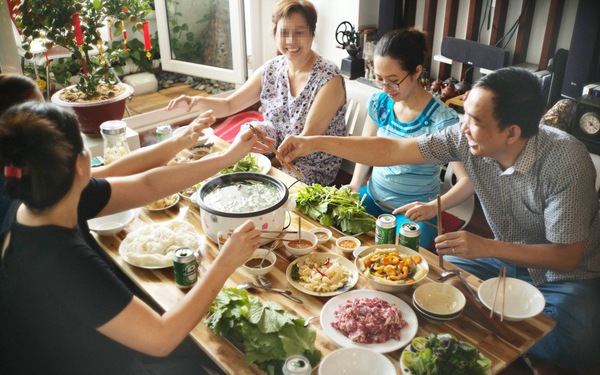 |
Tet is a great time for partying. Photo: Tuoi Tre |
This is why Prime Minister Nguyen Xuan Phuc requested on Wednesday that public workers resume work promptly now that the holiday was over.
“We should put an end to the outdated thinking that the first lunar month is a time for festivals,” the premier said as he chaired a meeting between the government’s standing board and some ministries and sectors.
Why not in the mood?
February 16 marked the first day of the Lunar New Year, ushering in the Year of the Dog in Vietnam
Many have devoted so much of their energy and motivation to Tet celebration that they went to work on Wednesday with little liveliness and enthusiasm.
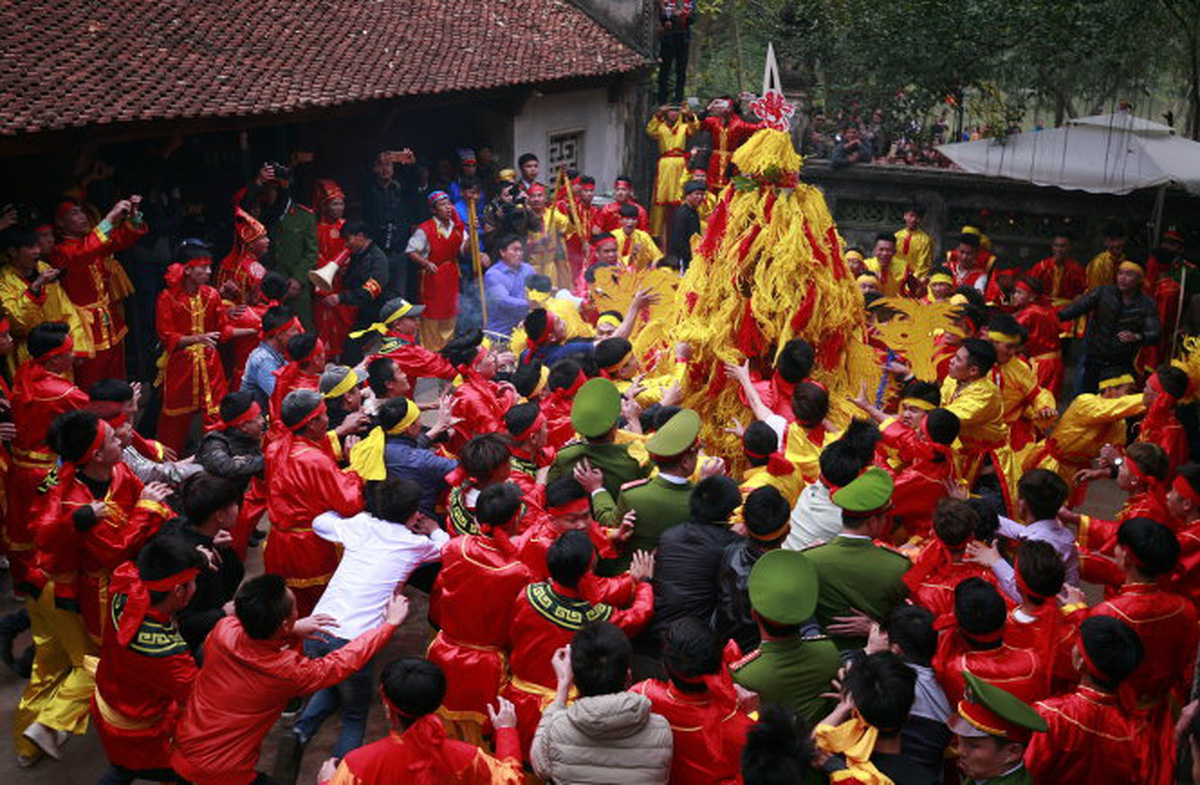 |
People get wild at a Tet festival in northern |
It is not unusual for offices to be scarce of employees, and those who were present would dedicate their time to talking about their holiday, sharing delicacies that they failed to use up over Tet, or even playing cards.
The common excuses for such a lack of working spirit are ‘I have yet to enjoy Tet to the fullest,” or “I have lost my energy having to return to the city from my hometown.”
Others argued that the ‘back to office’ day this year was in the middle of the week, so they found it hard to stay focused and motivated to work, with the weekend only three days ahead.
Some said they did not really enjoy Tet at all, having to join the Tet travel rush to their hometowns, where they had to visit a number of relatives and prepare holiday feasts.
Tet is also the great time for partying and drinking, and it is not easy for male workers to return to work sober when they made a toast to welcome the Year of the Dog every single night before.
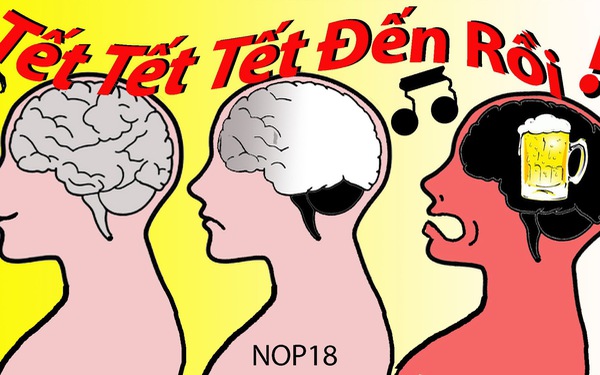 |
This Tuoi Tre caricature depicts how Tet celebrations may affect beer-lovers. |
And yet, for those in northern Vietnam
These include the three-month Huong Pagoda Festival, which started in Hanoi’s outer district of My Duc on Wednesday, the Bai Dinh Pagoda Festival in Ninh Binh, the Lim Festival in Bac Ninh and the Tran Temple Festival in Nam Dinh.
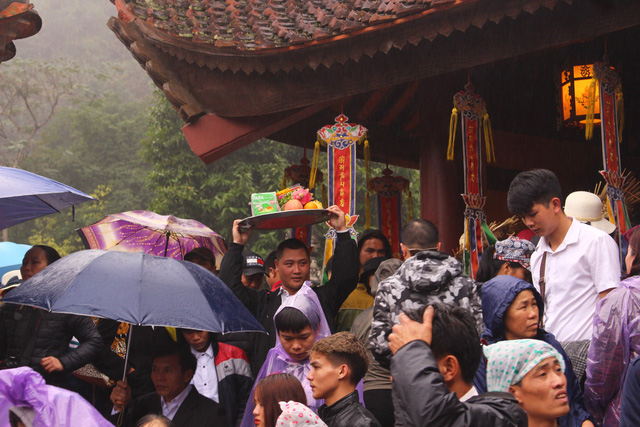 |
The Huong Pagoda Festival in |
By Son Luong / Tuoi Tre News
↧
Article 0
Loss-making fertiliser plant seeks further government support The Ninh Binh Nitrogenous Fertiliser Company has just proposed to get an additional loan of VND350 billion (USD15.43 million) from the government to save its loss-making plant.  Ninh Binh Fertiliser Plant has incurred big losses The proposal was made to minister of Industry and Trade, Tran Tuan Anh when he visited the plant on February 21.  Minister of Industry and Trade, Tran Tuan Anh (right) visit Ninh Binh Fertiliser Plant on February 21 At the meeting with the minister, the company's general director, Vu Van Nhan, said that the loan will help boost the plant's production activities after it resumed operation in January 2018. "We have mobilised VND63 billion (USD2.78 million) from customers for the plant's operation since January this year," Nhan told the meeting. "But to have that source of money we are having to sell our products at cheap prices. So need more capitals so that we can better control the market prices." The director shared that the plant is now producing 1,300 tonnes a day and have made approximately 27,000 tonnes of fertiliser this year of which 22,000 tonnes have been sold before the Tet holiday. Despite positive signs, Nhan said that the plant is still facing numerous challenges especially in sources of capital to maintain stable operations. "We need more support from banks," Nhan added. "It will cost us some VND40 billion a week to buy coal only for maintaining production, which is a big challenge which may make us being unable to meet the target of producing 120,000 tonnes in the first term of this year". The director called for minister Tran Tuan Anh's support so that they can have an emergency bank loan of VND350 billion to maintain operations. Nhan has also proposed and additional bank loan of over VND200 billion over three years to restore the plant's facilities in 2018. Addressing the meeting, minister Tran Tuan Anh pointed out the causes of the great losses at the plant, including weak management, slow actions by the Vietnam National Chemical Group and Ninh Binh Nitrogenous Fertiliser Company, as well as labour skills. "But we have to save the plant by all means," the minister stressed. "We will cooperate with the Vinachem to find out the best solutions to the plant's problems. But the Ninh Binh Nitrogenous Fertiliser Company will have to save them first by improving their product's quality and quantity." The USD667 million-invested plant, one of the ministry's top 12 loss-making projects, started operations in 2012 with designed annual capacity of 560,000 tonnes of fertiliser. Since its inception, the plant has continuously incurred losses with a total sum of over VND3 billion (USD132.22 million) by mid 2017. By Nguyen Khanh/dtinews.vn |
↧
↧
Article 3
The demand for hotel managers is always high in  The demand for hotel manager is always high in In an interview with the Vietnamese first dollar billionaire Pham Nhat Vuong, Thanh Nien newspaper raised a question about personnel training and development policy pursued by Vingroup. Vuong said that in the business fields that Vingroup is developing, it is very difficult to recruit Vietnamese managers. This was why Vingroup had to recruit foreigners for managers of its hotels and shopping centers. According to Forbes, The policies on expanding the visa fee exemption, applying e-visas, and increasing the number of international direct air routes and international airports have helped boost tourism development. Regarding accommodations,
Nevertheless, the hotel management market is now controlled by foreign groups. These include Intercontinental Hotels Group which runs 12 hotels and Hilton Hotels & Resorts which manages the Hilton hotel chains developed by BRG Group. Vietnamese businesses are aware of the attractiveness of the market, but are still inferior to foreign companies in the market. Explaining this, the director of a hotel said hotels now have to compete fiercely not only in An analyst commented that both domestic and foreign groups have to hunt for experienced managers, including veteran managers who are going to retire. In the past, the owners of 3-star hotels managed their hotels themselves. However, they now tend to hire professional managers because of stiff competition. Regarding the income of hotel managers, Le Dinh Tuan, who was a hotelier, said while foreigners receive sky-high salaries, the pay to Vietnamese is modest. A foreign CEO of a luxury hotel can earn $10,000-15,000 a month and enjoy luxury villa, private car & driver, and business-class air tickets, while a head of division can earn $5,000 a month. Kim Chi, VNN |
↧
Article 2
BUSINESS IN BRIEF 22/2 Exports of tra fish to 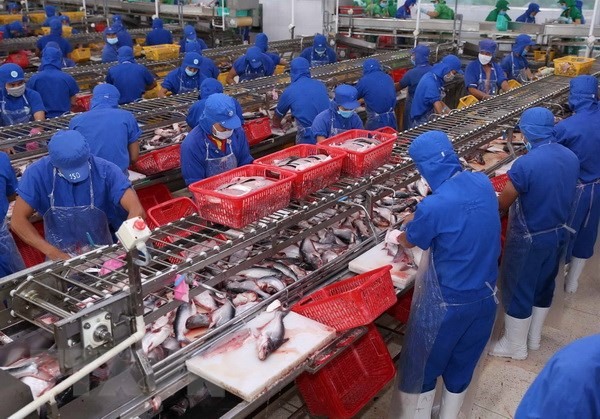 Tra fish exports to the It accounted for 2.6 percent of total tra exports. The Tra exports to many markets are expected to increase sharply this year. Ministry works to stabilise market following Tet Prices of essential goods in traditional markets returned to normal on the fourth and fifth days of the lunar year (February 19-20) after increases few days before the Tet holiday which lasted from February 14-20. According to the Ministry of Finance, supermarkets and commercial centres attracted a large number of consumers during the festival thank to clear product origins, guaranteed food hygiene and stable prices. Meanwhile, prices of catering and vehicle keeping services slightly increased in the first days of the year, the ministry said. During Tet, the purchasing power surged 12-15 percent as compared with normal days, and 10 percent against the same period last year, as a result of 2017’s noted economic growth and market stabilisation policy. The ministry said that demands for travelling, food and festival offerings are expected to rise following the holiday. To stabilise the market in March and the second quarter of this year, the ministry has asked other ministries, agencies and localities to keep a close watch on developments of supply and demand, as well as prices, especially of essential products. Besides, inspections on the observance of legal regulations on price, tax and fee, particularly of tourism services, while traffic laws will also be intensified. RON 95 petrol price drops by 400 VND per litre The price of RON 95 petrol declined by 400 VND per litre from 15:00 on February 21 as decided by the Ministry of Industry and Trade and the Ministry of Finance. The two ministries announced that the price of E5 petrol is not higher than 18,340 VND per litre, and those of diesel 0.05S and kerosene should not be higher than 15,716 VND per litre and 14,560 VND per litre, respectively. Meanwhile, the ministries also decided to adjust the price stabilisation fund for E5 bio-fuel at 600 VND per litre, while the use of the fund for RON 95, kerosene and diesel was 0 VND per litre. This is the first drop of petrol prices in 2018 and the first time that the ceiling price of RON 95 petrol has been announced as consumers no longer have access to RON 92 petrol since January 2018. The Ministry of Industry and Trade, and the Ministry of Finance review fuel prices every 15 days to adjust the prices in accordance with fluctuations on the world market. The average global price of petrol products during the last 15 days to February 21 was at 73.062 USD per barrel for RON 92 and 76.160 USD for diesel. Bac Ninh ranks second in FDI attraction in 2017 The According to the provincial Department of Statistics, Bac Ninh’s industrial production value reached 1 quadrillion VND (about 44 billion USD) and its export turnover hit 29.85 billion USD, accounting for 14.9 percent of the nation’s export earnings. The province collected 21.6 trillion VND (948.2 million USD) for the state budget. Meanwhile, the locality’s gross regional domestic product (GRDP) made up 3.25 percent of the country’s GDP, with a GRDP growth rate of 19.12 percent. Notably, the Samsung Group continued to pour an additional 2.5 billion USSD into the province, showing the province’s efforts to improve the investment climate. Bac Ninh is now home to over 1,000 FDI projects from 33 countries and territories, including many hi-tech and environmentally friendly projects with big value invested by Samsung, Canon and Foxconn. The flow of investment has been poured into 14 sectors, mostly in the processing and manufacturing industries. FDI projects have significantly contributed to the province’s economic development. To increase competitiveness in luring FDI, the local authorities have paid attention to simplifying administrative procedures, providing legal support for investors, developing industrial park infrastructure and improving the quality of human resources through promoting education-training activities. Vu Thi Phuong Thao, Vice Director of the provincial Department of Planning and Investment, said Bac Ninh will focus on attracting quality and high added-value FDI projects, especially in the fields of IT, bio-technology, hi-tech agriculture and infrastructure development. Priority will be given to encouraging joint-venture projects between domestic enterprises and foreign partners, especially those from Vietnam’s strategic partners such the US, European nations, the Republic of Korea and Japan, thus enabling domestic firms to join the global value chain, she added. Thaco launches new agricultural machine factory The Truong Hai Auto Corporation (Thaco) on February 21 launched its agricultural machine factory in Chu Lai open economic zone in the central province of Quang The factory covers 12,500 square metres and has an investment of 500 billion VND. It is designed to manufacture tractors with a capacity from 18HP-120HP, along with high-quality combine harvesters and other agricultural equipment. In the first phase, it has a capacity of manufacturing 2,000 tractors per year, 3,000 sets of cultivation equipment and 1,000 combine harvesters. The factory’s technology is transferred from LS Mtron Group, a leading agricultural machine manufacturer in the It will use domestic material and spare parts, while importing high technology parts that are not available in the country from the In 2018, Thaco will also focus on developing passenger cars, while launching the first phase of Thaco-Mazda factory with a capacity of 50,000 units each year on March 24, along with a new van factory to produce 100,000 units per year. The firm will also partner with other companies to develop support industry and expand its factories to 138 hectares in 2018. The recently approved project also aims to increase enterprises’ competitiveness and their awareness of integration, enabling them to intensively join the global value chain. It is hoped to help improve the national competitiveness, promote administrative reform and fine-tune business climate while perfecting the socialist-oriented market economy institution. Under the scheme, efforts will be made to fully tap business advantages, increase the quality and effectiveness of trade and investment promotion activities, and foster connection among ministries, sectors and business associations inside and outside the country in the work. Attention will be paid to bettering the quality of products and production methods through applying high technologies to meet export demand, and increase links among domestic and foreign businesses. Small and medium-sized enterprises (SMEs) will be updated on information and forecasts related to market, politics and exchange rate fluctuation; while other businesses will also be assisted in training human resources to improve their knowledge of international economic integration, bilateral and multilateral free trade agreements(FTAs) that Vietnam signed with foreign partners. Focus will be placed on taking advantage of investment trade agreements and calling for more investment projects from Coordination between the Vietnam Chamber of Commerce and Industry (VCCI) and business associations and between domestic agencies and representative agencies abroad will be strengthened, towards promoting the country’s economic development. Through implementing activities of the project, the VCCI will report and summit solutions to the Government, contributing to overcoming difficulties in trade and investment coordination between Surveys will be carried out to assess the needs, limitations and difficulties of enterprises and market potential so as to select markets for export and investment. Public-private dialogue mechanism and investment promotion will be bolstered, while SMEs will be supported in accessing advanced technologies and modernise production, helping them make inroads into more markets in strategic and important partner countries and join the global value chain. Japanese group builds auto parts factory in Thai Binh Construction on a 24.6-million USD auto parts factory is under-way in the northern Thai Binh province’s Tien Hai Industrial Zone with completion expected in July 2019. Financed by the Japanese Toyoda Gosei Group, the 11.3ha-factory will manufacture airbags and leather steering wheels which will be mainly exported to Japan, the US and Europe. Work on the factory kicked off early this month. Once operational, the factory is expected to create about 1,500 local jobs. The company said it believes that the project will contribute to accelerating the development of Thai Binh province as it will create more jobs for local people and improve their skills. Established in 1949 and headquartered in PM lauds Vietinbank, Vietcombank’s business results last year Prime Minister Nguyen Xuan Phuc lauded Vietinbank and Vietcombank for their business performance last year and encouraged them to make greater efforts to contribute to the fulfillment of The leader made the statements during visits to the headquarters of Vietinbank and Vietcombank, the two largest Vietnamese commercial banks, in The PM extended greetings to 24,000 Vietinbank employees in an event live-streamed in 155 branches of the bank nationwide. Phuc lauded Vietinbank’s successful equitisation, the growth of its technology-based banking services and its efforts to manage bad debts and improve management efficiency. He also mentioned the bank as a credit provider for the country’s key projects, backing the government to achieve its goals. He asked the bank to improve its competiveness by building financial and management capacity to international standards. Vietinbank should adopt solutions to improve and control credit quality; strengthen bad debt management; and continue stepping up administrative reform to provide start-ups and investors easier access to loans, he said. Later the same day, the PM met with Vietcombank staff on the occasion of the Vietnamese New Year, during which he praised the bank’s corporate culture. Vietcombank led in complying with the government’s policies, Phuc noted, adding that the bank is offering the market’s lowest lending interest rates though it has not reduced deposit interest rates. In a short time, Vietcombank’s total assets exceeded 1 quadrillion VND (44 billion USD) and its ratio of non-performing loans was down to 1.1 percent, the lowest among domestic credit institutions. The bank is also the first of its kind in He asked Vietcombank to broaden its vision to become a regional bank in He also suggested the bank develop banking technology and catch up with new technological trends, particularly in information security and safety. In 2017, VietinBank earned a total profit of 9.2 trillion VND (404 million USD), 105 percent of its annual target. The bank’s total assets notched a year-on-year surge of 15.3 percent to exceed 1.1 quadrillion VND (48.4 billion USD), making it one of Vietnam’s three largest banks in terms of assets and the country’s second-largest bank in terms of profit, after Vietcombank. Its outstanding loans reached 839 trillion VND (over 36.9 billion USD), up 18 percent year on year. Meanwhile, Vietcombank reported pre-tax profit of more than 11 trillion VND (482.5 million USD) last year. This was a record pre-tax profit achieved by a Vietnamese bank, representing a rise of 32.9 percent during the same period in the previous year and 16 percent higher than Vietcombank’s target. Total deposits amounted to 889.7 trillion VND (over 39.1 billion USD), up 38.7 percent year on year and 18 percent above set target. Outstanding loans reached 553 trillion VND (24.33 billion USD), an increase of 17.2 percent.- Deputy PM directs improving SOEs’ efficiency Deputy Prime Minister Vuong Dinh Hue has urged ministries, agencies and localities to promptly fulfill assigned tasks regarding equitisation and divestment in State-owned enterprises (SOEs), towards making them more transparent, healthy and efficient. He requested that SOEs restructure themselves in terms of apparatus, personnel, strategy, governance, finance, technology and products. He urged completely fixing shortcomings and weaknesses of SOEs as well as dealing with loss-making and inefficient firms and projects, and determining the responsibilities of individuals and units concerned. The Deputy PM asked ministries and agencies to review the Corporate Law, the Law on Management and Utilisation of State Capital Invested in the Enterprises’ Manufacturing and Business Activities, the Law on Cadres and Civil Servants, the Law on Bankruptcy, Labour Code and relevant legal documents so as to submit amendments and supplements to authorised agencies. Ministries, agencies, localities, State corporations and groups must continue hastening administrative reform and improving the business climate and legal environment towards achieving the goal of having 1 million enterprises by 2020, he said. They were also asked to urge equitised companies to list on bourses, strengthen supervision, audit to prevent capital loss and adopt corporate governance principles in line with international practices. Ministers, Chairs of People’s Committees of centrally-run cities and provinces and Chairpersons of Members’ Councils of economic groups must bear responsibility in this regard, he said. EVN resolved to ensure electricity supply The Electricity of Vietnam (EVN) will invest in power projects within local and national electricity development planning schemes from 2016-2020. This is the major task set in the group’s five-year business plan recently approved by Deputy Prime Minister Trinh Dinh Dung. Under the plan, EVN will develop renewable energy and improve environmental protection during the construction and operation of electricity facilities. The group will also safely run the national power grid, ensuring electricity supply and the economic efficiency of the electricity system. Another task is to revamp EVN’s subsidiaries in line with the master plan for rearranging and restructuring enterprises in 2017-2020. Along with developing the competitive electricity wholesale market, the group will bring electricity to rural, mountainous and island areas, aiming to help most households in these areas access the national power grid by 2020. During 2016-2020, EVN’s annual commercial power output is expected to increase by 10.08 percent. The group plans to put into operation up to 21 turbines with combined capacity of 6,100 MW of 12 projects, including Lai Chau hydropower project (operational in 2016), and the thermal power projects of Duyen Hai III, expanded Duyen Hai III, Vinh Tan IV, expanded Vinh Tan IV and Thai Binh I. Construction of another eight projects with a total capacity of 5,540 MW is also set to begin in the period. They are the hydropower projects of expanded Ialy, Hoa Binh and Tri An; and the thermal power projects of expanded Vinh Tan IV with its construction starting in 2016, O Mon III and IV, Quang Trach I and II. EVN will push preparations for the investment in the Tan Phuoc I thermal power project to put the plant into service by 2020, while building solar power projects. About 300 transmission lines of 500 kV and 200 kV with 12,200 km in length and 66,000 MVA in capacity of transformation stations are projected to become operational during the next five years. Other tasks for the group include improving the quality of electricity supply, increasing power imports from PM okays ultra-thin glass project in Ninh Binh Prime Minister Nguyen Xuan Phuc has approved in principle a plan to build an ultra-thin glass factory with capacity of 1,200 tonnes per day in Yen Khanh district, the The PM tasked the provincial People’s Committee to work with the Ministry of Construction to implement the project, ensuring the products to meet environmental standards. He also assigned the Ministry of Construction to review the master plan on development of building materials by 2020 with a vision to 2030, taking into account different types of glass to satisfy local demand and for export. NA Vice Chairman: e-customs facilitate import-export activities Vice Chairman of the National Assembly Phung Quoc Hien has hailed efforts made by the General Department of Customs in applying e-customs to facilitate import-export activities. In a meeting with the customs department in He also praised the sector’s efforts in preventing smuggling, counterfeit goods and trade fraud. On the occasion, the NA official wished that the customs officers will work to fulfill missions assigned by the National Assembly and the Government this year. Viglacera builds houses for industrial zone workers The Viglacera Corporation on Wednesday started construction of a housing project for workers in the Phu Ha Industrial Zone in the Tran Anh Tuan, director of the Viglacera projects management board, said the social housing project covered an area of 4.3ha in Ha Loc Commune of Phu Tho Town. The VND480 billion (US$21 million) project is expected to provide 630 apartments, ranging from 26sq.m to 70sq.m, to some 2,500 workers. The rent is estimated at VND30,000 per square metre. The project aims at improving the living standard of the employees, ensuring their commitment to the enterprise, as well as attracting more investments in the industrial zone. Viglacera committed to focusing its resources in the construction work so that the apartments can be rented as scheduled, Tuan said. Construction of Phu Ha Industrial Zone was kicked off on February 26, 2015. It has attracted $90 million from 13 enterprises mainly specialising in electronics and electricity production using advanced technology. The firms have helped create 10,000 jobs for the locality and neighbouring provinces. Hoang Cong Thuy, vice chairman of the provincial People’s Committee, said if the entire land in the industrial zone were to be hired for production activities, there would probably be 30,000 workers. Therefore, the project developed by Viglacera Corporation needed to meet the demand of current and future workers. The same day, the corporation inaugurated a VND16 billion waste water treatment plant in the industrial zone, with a capacity of 1,250cu.m per day and night. Viglacera Corporation is considered the leading company in building material industry in TT Group to become Vinafood 2’s strategic partner The industry-real estate-finance conglomerate T&T Group now has the highest chance to become the strategic partner of Viet Nam Southern Food Corporation (Vinafood 2), cafef.vn reported on Wednesday. Vinafood 2 plans to offer 25 per cent of its charter capital, or 125 million shares, to the strategic investor after the company launches its initial public offering (IPO) on March 14. As the price of shares offered to the strategic investor is expected to stay at least level to the IPO starting price of VND10,100 (45 US cents) per share, T&T Group may have to pay at least VND1.26 trillion ($56 million) to purchase those 125 million shares. Vinafood 2 had only received the filed proposal from T&T Group by December 15, 2017, on which Vinafood 2 must finalise its equitisation plan and submit the plan to the Ministry of Agriculture and Rural Development, the business news website reported. Local media had previously reported that T&T Group and the information-telecommunication-technology group FPT Corporation had expressed their interest in purchasing the strategic stake in Vinafood 2. However, only T&T Group had filed legal documents on the deal while FPT Corporation had submitted its copies of required documents, thus, FPT Corporation had been disqualified from the race. Therefore, Vinafood 2 had proposed the agriculture ministry approve T&T Group as its new strategic investor and submit the equitisation plan to the Prime Minister for approval. According to the company’s equitisation plan, the strategic partner must be financially healthy so that it could help the firm restructure its financial system and is able to assist Vinafood 2 seek new markets and open new distribution channels in both domestic and overseas markets. The strategic investor must meet some standards such as having operated in the agriculture sector for at least three years; having total assets of at least VND10 trillion by December 31, 2015; and achieving net profits for three consecutive years and reaching a return-on-equity ratio of more than 5 per cent. Under its equitisation plan, Vinafood 2 has a charter capital of VND5 trillion with 51 per cent possessed by the State. The company will sell nearly 23 per cent of its capital (114.8 million shares) at the IPO on March 14, offer 125 million shares to the strategic investor and the remainder to its employees and workers at a preferential price level. Vinafood 2 operates in importing-exporting food, processed food, agricultural products and trade of those products, but it has been struggling with the current business model as the finance, production and market and product development policies have been implemented ineffectively. Novaland seeks approval for overseas listing, issuing shares Novaland Investment Group Corporation has sought shareholders’ approval to list securities on international stock exchanges and issue additional shares. The real estate firm plans to list common shares, corporate bonds or convertible bonds on the Singapore Stock Exchange or another foreign stock exchange in 2018 or 2019. The board of directors or authorised persons are expected to execute the necessary procedures for the listing process. Novaland has also proposed a plan to issue a maximum of 100 million shares in a private placement to local and international investors this year. The offering price will be not lower than the book value per share at the time of issuance. The issuance aims to raise working capital, including capital of subsidiaries and affiliates, and buy shares in other companies, as well as help restructure its debts. Regarding the convertible bond issuance plan, Novaland will increase its bond value from US$250 million to $300 million. The issuance is projected to support the firm’s capital increase and debt restructuring. The bonds will be offered in a private placement to foreign investors with financial and technical capability to support the company’s business development. Investors will be subject to a one-year lock period since the date of issue. According to the adjusted plan, the bonds may be converted into ordinary shares (instead of the mandatory conversion in the old plan) at a minimum price of VND50,000 ($2.20) each, applying a dilution adjustment to protect the company and investors’ benefits. In addition to this, the firm has also sought the approval to supplement chairman Bui Thanh Nhon to the company’s legal representatives, in addition to its legal investment manager and chief executive officer. Novaland’s shares, coded NVL, has climbed nearly 23 per cent this year and is being traded at some VND80,000 per share on HCM Stock Exchange. Homemade tractors roll out in Quang Nam Local Truong Hai Automobile Company (Thaco) has rolled out the first made-in-Viet The factory, which covers an area of 1.2ha with investment of VND500 billion (US$22.1 million), plans to produce 2,000 tractors and 4,000 combine harvesters as well as farming machines and equipment each year. The Quang Nam-based factory uses technology from Korean LS Mtron company following an agreement signed last year between Thaco and LS Mtron (a company of the LS Group from Thaco said the manufacturing factory aimed to provide made-in-Viet Doan Dat Ninh, an official from Thaco, said the Thaco-trademark tractor eyed making up 7 per cent of the country’s market share in 2018 before increasing to 38 per cent in 2026. The local made farming machinery products are also planned to be exported to The introduction of the first agricultural machinery plant in In 2013, Thaco also acquired 51 per cent of shares in the Korean Soosung Motor Technology company to produce cranes, concrete mixer trucks and tankers in Thaco has manufactured and distributed vehicles of foreign brands – Kia of South Korea, Mazda of Japan, France’s Peugeot and BMW of Germany. VNN |
↧
Article 1
Social News 22/2 6 injured in pick-up truck collision with motorbikes  The pick-up truck after the accident in central Six people were seriously injured after a pick-up truck lost control and crashed into three motorbikes and a taxi on Wednesday afternoon in the central The pick-up truck was travelling from Phú Sơn Ward to It then collided with a taxi before coming to a halt. The driver, whose identity could not be ascertained, fled from the scene. The victims were rushed to a hospital for treatment. Provincial police are investigating the case. Lang Son launches tree-planting campaign A ceremony was held in The event was attended by local authorities and hundreds of youths and residents of the city. More than 300 peach blossoms trees were planted in the Mac Dynasty historical site. The same day, trees were also planted in other places, including historical sites, scenic spots and schools. Fruit trees were planted for social policies beneficiaries. In 2018, the province aims to plant more than 9,000 new hectares of forests, raising forest coverage to 62 percent. The two-day event drew the participation of more than 20 countries and territories across the world. The Vietnamese Embassy in Besides books on tourism introducing exciting destinations and unique features of regions, there also were maps and documents on At this year’s event, visitors could also enjoy a dance with conical hats performed by Vietnamese students wearing ao dai (traditional long dress), along with performances of the Vietnam Circus Federation. Vietnamese Ambassador to Egypt Do Hoang Long voiced his hope that the event will provide more information on Vietnamese culture for international friends. The Sakia Exhibition for Cultural Services is held annually and allows delegations to exchange cultural activities and boost unity and understanding. Vietnamese students in Moscow celebrate Tet Overseas Vietnamese at the Pushkin State Russian Language Institute in Moscow hosted an art show on February 21 to celebrate the traditional Lunar New Year (Tet). The event was attended by Minister-Counselor Lai Ngoc Doan from the Embassy of Vietnam in Addressing the function, on behalf of the Embassy, Doan extended Tet greetings to all participants and thanked to the institute’s leaders for organising the event. For his part, the institute’s President spoke highly of He expressed his hope that more Vietnamese will learn Participants also enjoyed a photo exhibition and Vietnamese food during the event. Hundreds more communes to become new-style rural areas in 2018 The number of communes meeting all criteria of new-style rural areas is expected to reach 3,300 – 3,400 (or 37 – 38 percent of the total communes across the country) this year, according to the Coordination Office of the national target programme on new-style rural. At the district level, the number will reach at least 53. A total of 3,069 communes and 43 districts earned the title of new-style rural area as of the end of 2017. Also this year, the number of communes meeting less than five criteria is expected to fall below 100. According to Nguyen Minh Tien, head of the office, the volume of rural roads built during the past six years was more than five times the volume built from 2001 – 2010. As of the end of 2016, all communes nationwide were connected to the national power grid, 99.7 percent had primary schools and kindergartens, 99.5 percent had medical stations, 99.4 percent had concrete roads to communal centres, and 4,498 communes had concentrated water supply stations. As many as 3,854 value chain-based production models have been established, helping form some large-scale production areas. In particular, the programme on “One Commune, One Product”, successfully piloted in Quang Ninh province, has been expanded to many localities and become one of the focuses in rural economic development. The Ministry of Agriculture and Rural Development has coordinated with the Vietnam Women’s Union (VWU) to encourage women’s involvement in the new-style rural area building programme. MARD Minister Nguyen Xuan Cuong highlight the increasingly important role of women in agriculture and new-style rural building, pointing to the fact that male labourers tend to shift to non-agricultural sector and move to urban areas to work. Women play the central role in socio-economic, cultural development, participate directly and actively and encourage their family members to join in infrastructure building and agricultural restructure, Cuong added. Large-scale agricultural cooperatives and farms will be developed with application of science and technology towards connected and safe production. Research will be conducted on developing climate change-resilient livelihood models for women, while the project on assisting women’s start-ups in agriculture and rural areas will be accelerated. Prime Minister visits farmers in Nam Dinh 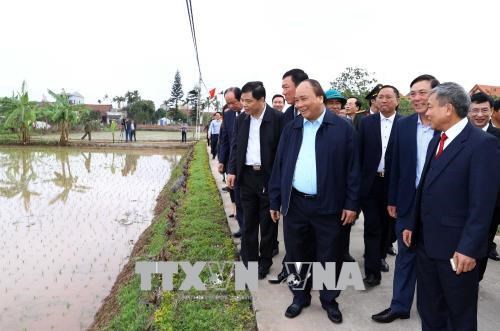 PM Nguyen Xuan Phuc toured paddy fields in Hai Hau's Hai Dong commune Prime Minister Nguyen Xuan Phuc paid a visit to farmers in Hai Hau district, the Hai Hau is among the four districts in Talking to leaders of Nam Dinh and Hai Hau, the Prime Minister lauded local farmers’ working spirit from the beginning of the lunar year. He urged Nam Dinh to strive for the goal of 100 percent of its districts meeting new-style rural standards and Hai Hau becoming an exemplary new-style rural locality. The PM directed local authorities to continue with agricultural restructuring in the direction of creating favourable conditions for businesses to invest in the sector. As part of his visit, PM Phuc and local leaders planted trees in Hai Hau’s Yen Dinh town to launch a new-year forestation festival that was set to see thousands of fruit and shade trees planted along roads and coastal areas across the district. The PM also toured paddy fields in Hai Hau’s Hai Dong commune and a waste treatment site in Xuan Truong district. Spring festival to honour national ethnic cultures A spring festival will be held at the The event will feature a wide range of activities, with a highlight being the re-enactment of the Gau Tao festival of Mong ethnic people and wedding ceremony of Bo Y ethnic inhabitants in the northern mountainous Gau Tao, held to thank gods for granting good health to families and villages, is one of the largest traditional festivals of Mong ethnic people. It combines almost all types of folk cultural activities of the group and has been recognised as part of the national intangible cultural heritage by the Ministry of Culture, Sports and Tourism. Meanwhile, the Bo Y ethnic minority group has managed to preserve their traditional culture from costumes and house architecture to wedding and funeral customs despite a small population. In the past, Bo Y people could only get married to those from the same ethnic group. But now, men and women are able to choose their partners from different ethnic groups. The wedding ceremony is usually organized in spring to pray for happiness and procreation. Another major activity will be a praying ceremony where monks from Khmer pagodas will pray for peace and blessing. People from Thai ethnic group in the northern About 1 million tourists visit Hung Temple relic site during Tet Nearly one million visitors came to pay tribute to Hung Kings and other ancestors who founded the country at the Hung Kings Temple Relic Site in the Director of the Management Board of the relic site Nguyen Duy Anh said the surge of visitors was attributable to favourable weather during the seven-day holiday, which fell on February 14-20. The Management Board has worked to ensure safety for tourists and restore some worshipping places, as well as arrange personnel providing guidance for visitors, he added. Vice Chairman of the provincial People’s Committee Ha Ke San said that the annual festival honouring the Hung Kings will be held in the province between April 21 and 25 (the 6th and 10th day of the third lunar month). The festival this year will be hosted by Phu Tho with the coordination of four other provinces, including the northern province of Thai Nguyen, the central province of Quang Nam and the southern provinces of Binh Duong and Kien Giang. An incense offering ceremony will be held at the Den Thuong (Upper Temple) on the death anniversary of the Hung Kings (April 25). Various activities will take place during the festival like a chung (square cake) making contest and preparing giay (glutinous round) cake; local delicacies exhibited at a fair and art shows. The event will also feature performances of Xoan singing, which has recently been recognised as UNESCO Intangible Cultural Heritage of Humanity. The Hung Kings founded the first nation in the history of To honour the Hung Kings, a complex of temples dedicated to them was built on The worshipping rituals of the Hung Kings are closely related to the ancestral worship traditions of most Vietnamese families, an important part of people’s spiritual lives. The worshipping ritual of the Hung Kings was recognised as UNESCO Intangible Cultural Heritage of Humanity in 2012. Anniversary of Hai Ba Trung Uprising marked in Hanoi A ceremony was held to mark the 1978th anniversary of the Hai Ba Trung Uprising at the Hai Ba Trung Temple, a special national relic site, in Hanoi’s Me Linh district on February 21, or the 6th day in the first month of the Year of the Dog. The event also celebrated a certificate recognizing the Hai Ba Trung Temple Festival as part of the national intangible cultural heritage. Prominent among delegates at the ceremony were Vice President Dang Thi Ngoc Thinh, Deputy Prime Minister Trinh Dinh Dung and former Vice President Nguyen Thi Doan. On the sixth day of the second lunar month in 40 AD, the Trung Sisters led a mass uprising against the Han invaders to reclaim national independence after more than 200 years of foreign rule. After defeating the invaders, Trung Trac became King. Three years later, the Han army returned and defeated the Trung sisters and their army, after which the sisters killed themselves by jumping into the Hat Giang river. The uprising has gone down in Vietnamese history as a demonstration of the nation's strength and patriotism, as well as the crucial role of Vietnamese women in national construction and defence. The festival comprises several rituals such as incense offering, a parade and folk performances. It will last until February 23, or the 8th day in the first lunar month. Bridge connecting Đá One of the two bridges connecting the mainland and Đá This is causing difficulties to tourists and residents on the island, said the local authority. The People’s Committee of Khánh Bình Tây Commune said around 7am on February 2, a portion of the bridge, spanning 30m, collapsed by 10 centimetres, preventing vehicles and pedestrians from entering or leaving the island. Nguyễn Quốc Đoàn, chairman of the commune’s People’s Committee, said the committee has sent a team to check the situation, give warning to vehicles and pedestrians and cover the damaged portion to ensure safety. Đoàn attributes the damage to a collision of sea vessels. He said the committee has reported the situation to the provincial authority so that it can come up with a repair plan for the bridge soon. Đá Of these, Đá Guitar duo at Indika Saigon Indika Saigon bar in District 1 will host a concert by Jazzaflip today. Jazzaflip consists of two guitarists, Thomas Noyer of On weekdays, happy hours are from 4pm to 8pm when all beer and rum punch are half-price. Entry is free. The bar is located at Lợi wins national motor racing champs Đoàn Trường Lợi of Phú Yên triumphed in the professional category of the National Motor Racing Championship, which concluded in the southern Đặng Tuấn Anh of the 306 racing team finished second. In the amateur event, Phạm Duy Tơn of HCM City took the title, followed by Tơn’s teammates Đoàn Quốc Huy and Nguyễn Thành Lộc. The tournament attracted the participation of more than 50 racers from several provinces across the country, such as An Giang, Đồng Tháp, Vĩnh Long and Cần Thơ. The event, which is co-ordinated by the provincial Department of Culture, Sports and Tourism and the Việt Nam Cycling and Motor Sport Federation, attracted thousands of supporters. Trọng to return to Hà Nội FC V. League 1 club Hà Nội FC has decided to recall midfielder Trần Đình Trọng from Sài Gòn FC to play for them in the upcoming football season. The 21-year-old player used to play for Hà Nội FC but was borrowed by Sài Gòn FC under a loan contract. The Hanoian has been a key player for Sài Gòn FC in the three recent tournaments. Strong, reliable and vigilant, Trọng helped Sài Gòn FC rank fifth in last year’s event. According to experts, Trọng is one of the potential young midfielders in Vietnamese football at present. He played well for Sài Gòn in the national premier league and for the national U23 team in the AFC U23 Championship in Trọng’s contract with Sài Gòn is valid until the end of this year. However, he will return to Hà Nội FC. “Trọng will come back to play for Hà Nội from the beginning of the league in March. With Trọng’s presence, Hà Nội’s defence line will be very strong,” said Nguyễn Quốc Tuấn, deputy director of Hà Nội FC. “I am very happy to be back to play for the capital team. I will give my best to my native team,” Trọng said. Huế holds wrestling bout to warm up new year Huế held a wrestling bout as a recreation event during the new lunar year on Wednesday. Sports authorities in the According to the elderlies in the village, the bout is traditionally held on the sixth day of a new year, starting from the Nguyễn Lords (1558-1777) era, for selecting healthy men for soldiers. The tradition later was resumed by the lords’ descendant Nguyễn Dynasty (1802-1945) until today. A sandy round bout is made in front of the communal house of the village, where young men from the village and nearby villages come for competitions under the Vietnamese traditional wrestling rules. The rules require a wrestler to make his rival “lấm lưng trắng bụng,” which means sticking the rival’s back to the sand’s surface while his stomach faces the sky, to win a game. The rules does not allow any vicious attacks, pushing or attempts to choke or break the rival’s hands and legs. The rules of the game remain the same today, but there is a difference, as it welcomes amateur wrestlers from localities throughout the province, and not the nearby villages only. Wednesday’s bout started with a pair of old men performing the techniques during a ritual ceremony. Later, several games were held for female wrestlers. Games for men were much more thanks to the number of wrestlers who came and registered to compete right before each game. Hồ Đăng Trọng Khánh, a winner at games held for youth, said he was attracted by the games and travelled 20km from Meanwhile, Nguyễn Quang Khánh, a local wrestler said he took part in the game to maintain his village’s tradition. As the organisers had no chance to categorise competitors according to their weight days before the bout, several games were held between a 65kg man and a 110kg rival. Some others were between 51kg and 85kg. This made the bout really thrilling as the thinner competitors outclassed their heavier rivals through their courage and cleverness. Boat races celebrate Lunar New Year As part of a series of cultural activities being held across the country, a boat racing competition was held on the Lô River in the The festivity – a unique river festival of The festival, held annually by the Also on Monday, a boat race was held on the Đăk Hailstorms destroy hundreds of houses in Nghe An Two hailstorms occurred on Wednesday afternoon in central Nghệ An Province, blowing away the roofs of hundreds of houses in two communes, local authorities said. No fatalities were reported. Vi Văn Thành, chairman of the Châu Lý Commune’s People’s Committee, said the hailstorm began at 3pm. Besides damaging houses, the storm uprooted many trees. At the same time, another hailstorm occurred in Nghĩa Xuân Commune, partly destroying 15 houses. According to residents, the two storms occurred 30 minutes after a heavy downpour. The hailstones were about the size of a finger. They said hailstorms have never occurred in the first month of the lunar new year before. Local authorities have sent a team to help the affected residents with food and repair damaged houses. VNN |
↧
Article 0
Government News 23/2 President Quang kicks off New Year tree planting festival 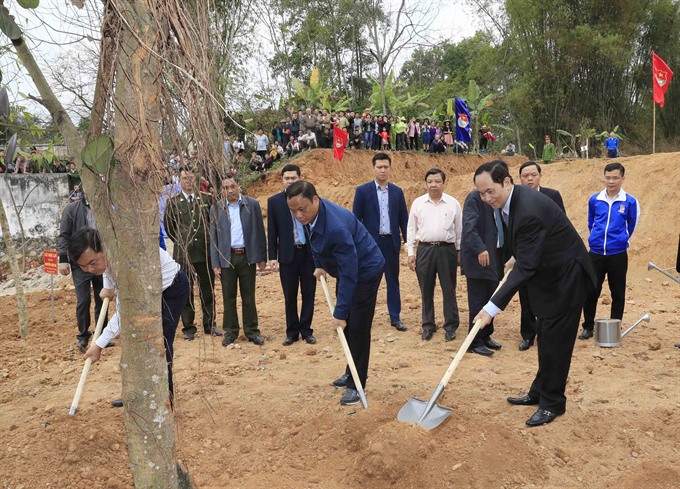 President Trần Đại Quang (right) launches the New Year tree planting festival in Bạch Thông District, the northern mountainous President Trần Đại Quang launched the New Year tree planting festival in Bạch Thông District, the northern mountainous On November 28, 1959, President Hồ Chí Minh wrote an article which was published in the Nhân dân (People) newspaper, stressing the significance of tree planting to each person, each family and the entire nation. It has since become an annual Vietnamese custom each Lunar New Year. According to the Ministry of Agriculture and Rural Development, 235,000ha of concentrated forests and over 60 million scattered trees were planted nationwide last year. Meanwhile, 6.1 million ha of forests were protected and 335,000ha were zoned off for forest regeneration. The number of violations in forest management and protection decreased by 23 per cent, the total acreage of damaged forests fell by 68 per cent annually, and forestry exports hit US$8 billion. The rate of forest coverage reached 41.45 per cent, making contributions to the common growth of the agricultural sector. In accordance with the Target Programme on Sustainable Forestry Development for 2016-2020, the sector targets raising forestry production value by 6-6.5 per cent, increasing forest coverage to 42 per cent and forestry exports to $10 billion by 2020, contributing to mitigating natural disasters and reducing poverty in combination with new-style rural development and ensuring national defence-security. Speaking at the event, President Quang underlined the strategic significance of tree planting and forestation amidst the threats of global warming and climate change. He called on ministries, agencies, localities and people nationwide to raise public awareness of forest protection and prevent illegal logging. Tree planting festivals were also held yesterday in many localities across the country. Prime Minister attaches importance to Party’s leadership 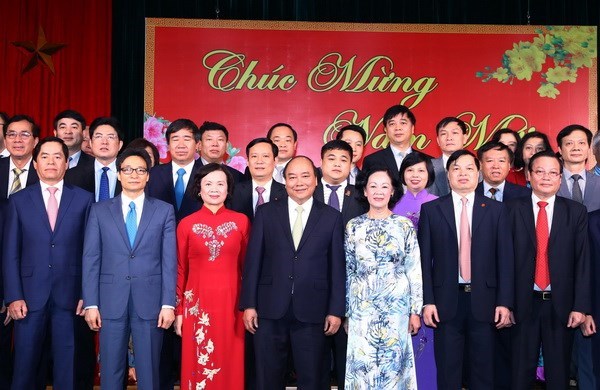 Prime Minister Nguyen Xuan Phuc (front, centre), Chairwoman of the Mass Mobilisation Commission Truong Thi Mai (front, third right) and other officials at a gathering on the occasion of the Lunar New Year on February 22 The Government leader made the statement at a gathering on the occasion of the Lunar New Year in Hanoi on February 22 with the participation of officials and employees of the Party Central Committee’s Mass Mobilisation Commission, the Party Committee of the Central Agencies Bloc, the Party Committee of the Central Businesses Bloc, and the Party Committee of overseas Vietnamese agencies. PM Phuc recognised the committees’ efforts in their work and giving timely advice serving the Party in leading the country and State agencies in implementing their functions and duties. He said the Party committee of the Central Businesses Bloc plays an important role in facilitating and promoting national development, as the Central Businesses Bloc is crucial in directing the socialist-oriented development of State-owned enterprises, which greatly contribute to GDP growth and national development. The Party Committee of the Central Businesses Bloc should coordinate closely with the committee for managing State capital in enterprises to manage State capital and Party members in these firms well, the Government leader said, noting that he will spend more time working with the Mass Mobilisation Commission and other Party agencies to address problems arising. Chairwoman of the Mass Mobilisation Commission Truong Thi Mai shared PM Phuc’s view on continuing to bring about people’s role in building the Party and reforming operations to meet growing requirements set by the Party. She also congratulated the Government, the PM and all-level authorities on their successes in 2017. PM requires Hoa Lac Hi-Tech Park to form startup ecosystem  Prime Minister Nguyen Xuan Phuc has expressed his wish that the Hoa Lac Hi-Tech Park in the outskirts of Visiting the park on February 22, PM Phuc said he hopes that it will be filled with investment activities at an early time, and become a big production centre of the capital city, thus contributing to the country’s science and technology development and bringing the added value to the economy. He asked ministries, sectors and the Specifically, the Ministry of Science and Technology (MoST) need to carry out measures to realise policies to attract more high-quality human resources, while the Hanoi People’s Committee should help speed up the land clearance process to quickly complete the park’s construction, he said. The Government leader also requested the MoST and related offices to soon grant investment licences to NIDEC Group, which decided to pour 400 million USD into the first phase of its two projects and plans to invest in three more projects with a total registered capital of 1 billion USD in the next stage. Located in Hanoi’s Thach That and Quoc Oai districts, the 1,586ha Hoa Lac Hi-Tech Park is expected to become a science city hosting investors in biotechnology, information – communication, new material technology, and automation. Modern infrastructure is being built at the park using the State budget and the official development assistance (ODA) provided by the Japanese government. As of late 2017, the park had 81 valid investment projects, with a total registered capital of over 66 trillion VND (2.9 million USD), on an area of 358ha. Last year, the park attracted many big technological projects, including the Hamvha Techwin company’s 200-million-USD Hamvha Aero Engines project. PM lauds workers’ contributions to national development  Prime Minister Nguyen Xuan Phuc (third, right) and officials of Prime Minister Nguyen Xuan Phuc applauded contributions of workers to the country’s development in 2017 during his visit to the The leader also hailed the VGCL’s efforts to bring a warm Tet holiday for all workers, particularly those in disadvantaged circumstances. He commended the VGCL and the southern He asked the confederation to make thoroughly preparation for a programme of dialogues between the PM and workers in the northern region. Recalling similar dialogues held in the southern and central regions in 2016 and 2017, PM Phuc said he heard workers’ proposals for institutions of culture, housing, kindergartens and canteens. Since then, a number of such facilities have been built, initially bringing tangible benefits to workers, he noted. As the VGCL will hold a national congress later this year, the PM said trade union congresses at all levels should include the fourth industrial revolution in their agenda in order to seek ways to improve professional skills for Vietnamese workers, helping them catch up with scientific and technological advancements in the new context. PM Phuc also noted that labour and trade union issues are part of negotiations of the Comprehensive and Progressive Agreement for Trans-Pacific Partnership (CPTPP), and asked the confederation to take the initiative in assisting workers in enhancing their skills and proposing suitable legal institutions to protect rights and interests of the worker class amidst the competitive environment. The PM also requested the VGCL to coordinate with competent agencies to develop more trade union institutions for workers, which, he said, have remained limited. Earlier, the PM approved the VGCL’s project on building trade union institutions at industrial parks and export processing zones. VFF leader highly evaluates role of member organisations 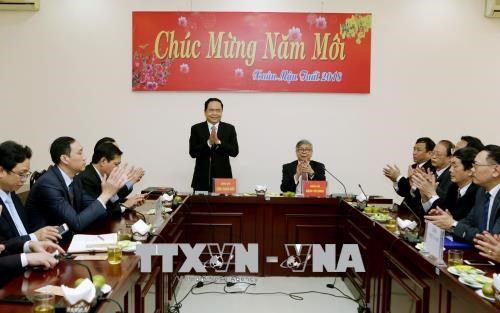 President of the Vietnam Fatherland Front Central Committee Tran Thanh Man works with the Vietnam Union of Science and Technology Associations (VUSTA) President of the Vietnam Fatherland Front (VFF) Central Committee Tran Thanh Man on February 22 visited the Vietnam Union of Science and Technology Associations (VUSTA) and the Committee for Solidarity of Vietnamese Catholics – two member organisations of the VFF. Praising the outcomes of collaboration between the VFF and the VUSTA, Man noted that the union has effectively implemented joint projects between the two sides. He acknowledged the VUSTA’s contributions, expressing his wish for more bilateral cooperation programmes to capitalise on capacity of intellectuals and scientists in science-technology, education-training, and environment-climate change adaptation. The VFF and the VUSTA should work together to compile outstanding works and publications, and to launch the Vietnam Innovation Golden Book. Visiting the Committee for Solidarity of Vietnamese Catholics, Man expressed his delight at the work done by the committee in promoting policy and law abidance, and patriotic campaigns among VFF’s members. He lauded the committee’s participation in charity activities, human resources training, and environmental protection. Man said in the coming time, the committee must continue its contributions to increasing public awareness of the government’s policies and consolidating national solidarity. Equatorial Guinea keen on expanding ties with Vietnam 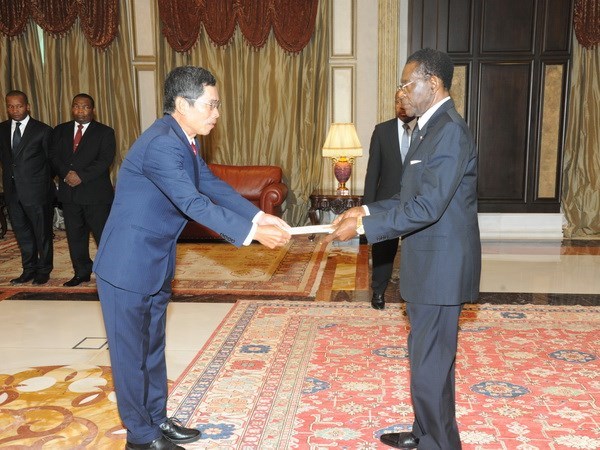 Vietnamese Ambassador to Equatorial Guinea Nguyen Manh Cuong (L) presents his credentials to President of the host country Obiang Nguema Mbasogo Vietnamese Ambassador to Equatorial Guinea Nguyen Manh Cuong has presented his credentials to President of the host country Obiang Nguema Mbasogo who affirmed his country is interested in expanding ties with President Mbasogo underlined the warm feelings he and people of the central African country have for He lauded the achievements of He said the experience of Ambassador Nguyen Manh Cuong highlighted the hope to intensify ties with Equatorial Guinea of President Tran Dai Quang and other senior leaders of He also pledged to work hard to bolster links between the two countries. VNN |
↧
↧
Article 2
BUSINESS IN BRIEF 23/2 PTSC to make $57 million investment aboard  PetroVietnam Technical Services Corporation (PTSC), a subsidiary of PetroVietnam, will contribute $57 million to the establishment of a joint venture company with Yinson Clover Ltd. (YCL) in the Marshall Islands. Establishing the joint venture company is a clause in a contract signed between YCL and Talisman Vietnam 07/03 BV (TLV) in May 2017. The joint venture is named PTSC Ca Rong Do Ltd. and carries a total investment capital of $111.62 million, 51 per cent from PVS and the remaining 49 per cent from YCL. Under the proposed joint venture, the two companies will jointly undertake the execution and performance of the bareboat scope of work, including the bareboat charter of the floating production storage and offloading (FPSO) under the time charter contract. Previously, in May 2017, YCL was awarded a contract from TLV for the supply, operation, and maintenance of a floating production storage and offloading (FPSO) facility for the Ca Rong Do (CRD) field development—block 07/03 offshore Vietnam. TLV is a wholly-owned subsidiary of Repsol, the operator of the CRD field. The contract is for a fixed period of 10 years, with five yearly extension options exercisable by TLV. The estimated total aggregate value of the bareboat charter is approximately $1 billion for the entire 15-year charter, inclusive of all five yearly extension options. As required under the contract bid, YCL entered into an agreement with TLV and PTSC for the novation of all rights and liabilities under the contract to PTSC. PTSC and YCL will subsequently form a joint venture company which will enter into a bareboat charter contract with PTSC for the bareboat scope of work under the contract. A member of PetroVietnam, PTSC was established in February 1993 through the merger of two units, Petroleum Service Company (PSC) and Geophysics and Petroleum Service Company (GPTS). PTSC’s main field of operation is supplying technical services to the oil and gas and industrial sector, including engineering procurement construction and installation (EPCI) for offshore facilities; implementing engineering-procurement-construction (EPC) for industrial facilities; FSO/FPSO services; offshore support vessels; seismic survey services; as well as geophysical and geotechnical survey services, among others. Australian businesses to research on Vietnam shrimp production chain An Australian workgroup will visit Vietnam on February 26 - March 2 to do research on Vietnam’s shrimp production chain for export to the country, according to the Department of Animal Health under the Ministry of Agriculture and Rural Development. The specialists will focus on seafood disease prevention and supervision, and quarantine licensing. They will visit labs responsible for testing diseases on exported shrimps, and shrimp farms in Soc Trang, Bac Lieu, Kien Giang and Ca Mau provinces. The Department has asked relevant agencies, including the Vietnam Association of Seafood Exporters and Producers (VASEP) and seafood exporters to Australia to help businesses work with the Australian specialists. According to the Vietnam Trade Office in Australia, seafood has great potential to make inroad into the market with annual consumption demand for around 1 million tons. However, domestic production meets only 30% of its demand. Currently, Vietnam is the fourth largest seafood supplier of Australia with 11% of market shares after Thailand, New Zealand, and China. Particularly, it is the biggest shrimp exporter to the market with more than 35% of market shares. The Office strongly recommends that Vietnamese businesses should strictly observe Australia’s food hygiene and safety and biosafety regulations to enter the market. Seafood exports hit a record high of US$8.3 billion last year, up nearly US$1 billion compared to the previous year. Binh Duong: firms need over 20,000 labourers in early 2018 More than 500 enterprises in the southern province of Binh Duong registered with the provincial job placement centre to seek 20,803 workers before and after the Lunar New Year (Tet) holiday, the centre said. They needed 16,785 unskilled workers, or 80 percent of the recruitment, with the rest skilled labourers. Most of the jobs are in transport, construction, office jobs, footwear, garment-textile, electronics, footwear and wood exports. Apart from advertising on mass media, the province plans to establish employment transaction floors to connect labourers with enterprises. According to Nguyen Thanh Phuong, Deputy Director the centre, in February, demand for employees in the province increased to serve the Tet holiday period and fill gaps because many labourers often change jobs after the holiday. Only 25 percent of local labourers returned to work on February 22 (the seventh day of the first lunar month) after the Tet festival, up five percent from the same period last year. The figure was estimated at 40 percent in local industrial parks. Located in the southern key economic region, Binh Duong is a leading industrial hub in Vietnam. Currently, Binh Duong is home to 29 industrial parks with total area of 12,790 hectares, of which 26 are operational. By 2020, the province has 34 industrial parks with a combined area of over 15,000 hectares. In 2017, the province lured more than 2.5 billion USD of foreign direct investment (FDI), exceeding its target by 79 percent, up 125 percent over 2016. Of which, 80 percent was disbursed, higher than the average figure of the previous years at 78 percent. The southern province hopes to attract 1.4 billion USD in FDI in 2018. Binh Duong customs facilitate import-export activities during Tet The Customs Department in the southern province of Binh Duong maintained uninterrupted import-export clearance procedures during the Lunar New Year holiday (Tet). On the week-long holiday, which lasted from February 14 to 20, the agency received 220 documents for import-export transactions from 25 companies, with a total goods value surpassing 7.19 million USD. A list of customs officers at work throughout the period was posted publicly to facilitate importers and exporters in case of emergency. Inspection activities were also intensified to prevent goods smuggling and counterfeits, which are likely to be on the rise around Tet. Re-established on January 1, 1997, Binh Duong is located in the southern key economic region. With its drastic reform policies, the province has risen to a leading industrial locality of the country and one of 13 localities nationwide having the highest budget collection. Quang Tri lures 160 billion VND in hi-tech agriculture The central province of Quang Tri has attracted eight projects in high technology and green agriculture worth over 160 billion VND (7.02 million USD), according to the provincial Department of Agriculture and Rural Development. Notably, an automatic hydroponic project with an investment of 2 billion VND has been developed in Hai Lang town, Hai Lang district, covering 2,000 square metres. Nguyen Giap, Vice Chairman of the People’s Committee of Hai Lang district said that hi-tech agriculture has been effective, attracting the involvement of many farmers. He pledged that Hai Lang will create optimal conditions in land use and policy for investors in hi-tech agriculture. He highlighted the close coordination between the local government, enterprises and farmers in the field, pointing to a number of outstanding projects, including a nearly 80 billion VND project jointly implemented by the Quang Tri People’s Committee and Dong Giao company to develop a pineapple-growing region spanning the districts of Vinh Linh, Cam Lo and Dakrong. Currently, Quang Thi has focused on restructuring its agriculture, with priority on high technology agriculture to produce high quality products and adapt to climate change. The province plans to support investors in land use, capital and policy to develop projects growing key plants such as pepper, rice, vegetables and fruits. Dong Nai-based firms keep stable activities after Tet Businesses in Dong Nai province, an industrial hub in the southern region, have resumed normal activities with a stable worker situation after the Lunar New Year holiday (Tet). Nguyen Thi Thao, whose hometown is in the central province of Ha Tinh, said her company – Taekwang Vina, which employs over 30,000 labourers, organised coaches to bring workers home for Tet and back to Dong Nai’s Bien Hoa city after the holiday was over. All workers are excited to resume their work. According to Dinh Sy Phuc – head of the trade union of Taekwang Vina, about 99 percent of the workers returned to work in the morning of February 22, the first workday after Tet. Pham Van Cuong, deputy head of the Dong Nai Industrial Zones Authority, cited local businesses as reporting that about 95 percent of the total firms resumed normal activities on February 22. About 95 percent of their labourers have also returned to work. Dong Nai is currently home to 35 industrial parks with more than 1,510 investment projects, including some 1,100 foreign-invested ones, with about 900,000 workers. About 70 percent of workers in Dong Nai come from other provinces, mostly in the central and northern regions. Viglacera builds Dong Van IV IP’s infrastructure Viglacera Corporation on February 22 started construction of a power project and a wastewater treatment facility at the Dong Van IV Industrial Park in the northern province of Ha Nam. Viglacera partnered with the Northern Power Corporation to begin installing electricity lines and a 110/35/22kV transformer station to ensure stable power supply at the industrial park and reduce load on the 110kV Dong Van transformer station. The firm also commenced work on the wastewater treatment plant with a total investment of 24 billion VND (over 1 million USD). The first phase of the plant will be capable of treating 2,000 cu.m of wastewater per day and expected to complete in June. These projects aim to aid Viglacera’s efforts to attract more big investors in electronics and high-tech areas to the IP. Viglacera began developing the Dong Van IV IP in Ha Nam in 2016. Covering an area of 600 hectares in Kim Bang district, the IP includes two phases. It is expected to create jobs for 500,000 workers in the province, as well as four million people from neighbouring localities. A year from the ground-breaking day, the IP has signed agreements to host several projects from the Republic of Korea, mostly manufacturing automobile, refrigerators, washing machine, and microwave ovens. Gotu Kola plant earns Hue farmers a decent life Farmers in the central province of Thua Thien-Hue are earning good money by growing Gotu Kola, a plant used for daily meals as vegetable and an ingredient in herbal medicine, commercially. A decade ago, farmers in the lowland Quang Tho commune in the province’s Quang Dien district began planting Gotu Kola to replace rice and common vegetables, including sweet potato, which were giving them low yields. According to Nguyen Luong Tri, chairman of the cooperative producing Gotu Kola in the commune, locals earlier harvested wild Gotu Kola only for their own meals until they found the plant was not abundant in nature and quite expensive in the local markets. The plant was, however, much in demand among the locals, not only for meals, but also to create a homemade drink for lower temperature, as well as to be boiled and used for bathing children to reduce itchy skin and pimples. Tri said locals started growing the wild plant on their soil. After a few years, the demand for Gotu Kola increased in the local markets, accruing good profits to the growers. The number of growers also increased. A report by the district’s Agriculture and Rural Development Division said the commune has 45ha growing the plant, and Quang Thanh, another commune, had also started growing the plant in recent years. A hectare of the plant yields five tonnes of Gotu Kola in one cutting. The plant grows again after it is cut, and local farmers can cut it 10 times a year. The quantity yields an annual income of 300 million VND per hectare to the local farmers, much higher than rice. Tran Dinh Nam of the division said there are some 200 families in Quang Tho growing Gotu Kola, and nearly 90 percent of the farmers are growing the plant under Vietnamese Good Agriculture Practice (VietGAP) since 2010 to meet the demand of organic consumers. Local farmers said they planned to expand the area for this plant. Nguyen Thi Xi, a Gotu Kola farmer in the commune, said she wanted to double the area of 0.3ha to meet the increasing need. “The plant earns my family an income that is sufficient for three school-going children. We are no longer poor,” she said. Nguyen Thi Loan, another grower, said the plant does not require as much manpower as to grow rice, and so, she planned to increase the area. Tri of the cooperative said the green Gotu Kola produced by local farmers is consumed daily by traders in the province, the nearby provinces of Quang Binh, Quang Tri and Da Nang, and the neighbouring countries of Lao and Cambodia. Since 2015, the cooperative began producing Gotu Kola tea by grilling, drying and packaging the green plant, using industrial machines. According to Tri, the tea is approved by the Ministry of Health for circulation in the market as a type of supplementary food. He said the high consumption need in the market, as well as the demand from tea making factories, have helped the cooperative to purchase all the plant products produced by local farmers, giving them a sound income of at least 50 million VND to 150 million VND a year, depending on the area. “With a by chance beginning, locals have obtained a decent life with the plant today,” he said. HCM City to pay interest for hi-tech farms Ho Chi Minh City will subsidise interests on bank loans by up to 100 percent to support individuals and organisations who help transform its agricultural sector. Resolution No 10/2017 of the municipal People’s Council, which seeks to encourage investment to transform the farm sector into a modern, efficient and sustainable one in 2017-20, provides for the subsidy. The loan amount entitled to the support will be based on the investment scale and the regulations of the lending organisation. The subsidy will be equal to the average 12-month VND deposit interest rate at four State-owned banks - Agribank, BIDV, Vietcombank, Vietinbank - plus 2 percent. If the lending interest rate is lower than the subsidy rate, the subsidy provided will be equal to the former. The subsidy will cover the following components: basic construction, machinery and equipment for agricultural production and processing, harvesting birds’ nest, buying new fishing vessels and upgrading machine capacity, replacing existing unproductive dairy cows, and seed and hi-tech agricultural production. The term of support will depend on the approved production cycle but not exceed five years. Individuals and organisations investing in growing orchids and bonsai, raising ornamental fishes, cows for dairy and meat, and aquaculture will get 80 percent interest subsidy. Those signing contracts for production and consumption of agricultural products, buying raw materials to develop rural areas, fishing, animal feed production, and eco-tourism will get 60 percent subsidy. The support term will not exceed 12 months in case of crop and livestock farming with a production cycle of less than 12 months. If production cycles exceed 12 months, the duration will depend on the cycle but not exceed 36 months. For consumption of agricultural products too, the support will last from 12 to 36 months. Vietnam’s squid and octopus exports to US surge Vietnam’s squid and octopus exports to the US reached 9.7 million USD last year, up 94.7 percent from 2016, reported the Vietnam Association of Seafood Producers and Exporters (VASEP). Two major products exported to the US are frozen squid and frozen octopus. In 2017, squid and octopus exports to the US increased from more than 1 million USD in the first quarter to 3.5 million USD in the fourth quarter. Statistics of the US International Trade Commission (ITC) showed that the country imported squid and octopus from 38 sources worldwide in the first 11 months last year, worth 295.8 million USD, down 29.2 percent from the same period of 2016. Vietnam is currently the ninth largest source of supply for this market. The average price of squid and octopus in Vietnam is currently high at 7.4 USD per kg, while that of India is 5 USD/kg, China 5.1 USD/kg, Indonesia 6.8 USD/kg and Thailand up to 8.7 USD/kg. Food prices edge up after Tet due to low supply After Tet the prices of vegetables and foodstuffs in HCM City have become higher than normal. Several markets in the city are selling them at inflated prices due to low supply since traders and vegetable growers have not resumed full-fledged activities yet. For instance, cabbage is selling at VND10,000 per kilogramme, double its usual price, while broccoli costs VND40,000, VND5,000 higher than normal. The prices of clams and fish such as featherback and snakehead have also increased by VND10,000-20,000 per kilogramme. Many fishing boats have only recently gone out to sea after the New Year and have yet to return, meaning supply is relatively low. According to traders, families sought after vegetables and seafood more after consuming a large amount of meat during Tết. Food stalls in many markets opened on Monday - before most other stalls did, but demand has been relatively low due to the high prices. Some of the stalls are closing sooner than usual as a result. The city Department of Trade said it expects prices to stabilise soon. Creador to invest additional US$100 million in Vietnamese M&A deals After spending more than $40 million on buying into Mobile World Investment JSC (HoSE: MWG), Kuala Lumpur-based investment fund Creador will continue to invest an additional $100 million in M&A deals in Vietnam in the next three years. This was announced by Brahmal Vasudevan, CEO of Creador, at a recent interview with Dealstreetasia. Brahmal Vasudevan said that the fund is impressed with the speed of economic growth in Vietnam. Besides, it sees similarities between Vietnam and China and India, which are two of its main investment destinations. At present, the fund is collecting capital for the $500-million investment fund named Creador IV. The collection is expected to be completed in June this year and Creador will spend 20 per cent of this capital ($100 million) on investing in M&A deals in Vietnam. Previously, in January, Creador completed the purchase of five million shares, or a 35 per cent stake, in MWG for $43 million from Mekong Enterprise Fund II. “With a thriving young population and rising disposable incomes, we foresee robust growth in the Vietnamese consumer sector. MWG stands out among its peers, not only because of its dominance in offline retailing, but also its market-leading position in online retailing with 16 per cent market share currently,” Creador said in a note to investors. Established in 2011, Creador is a private equity firm focused on partnering with passionate entrepreneurs to grow world-class businesses in South and Southeast Asia. The private equity firm closed its previous vehicle at $415 million in late 2016. It specialises in investing in finance, retail, F&B, pharmaceuticals, media, and business supporting services. The core geographies are Malaysia, Indonesia, Singapore, and India, with deals in other markets considered on an opportunistic basis. Grab makes takeover bid for Uber’s SEA operations, including Vietnam: reports Southeast Asian ride-hailing firm Grab has been in talks with rival Uber to acquire its regional operations in a bid to tighten its grip on the rapidly growing shared transportation sector, Kr-Asia quoted people familiar with the matter as saying. As the world’s fourth-largest internet market, Southeast Asia has a mushrooming young population with more disposal income. Uber has reportedly been unable to turn a profit in its Asian markets, where it faces fierce competition from homegrown players like Grab in Southeast Asia, Go-Jek in Indonesia and Ola in India. Uber CEO Dara Khosrowshahi has acknowledged the challenges Uber faces in Southeast Asia, saying the market is “over-capitalized at this point.” “We’re going in, and we’re leaning forward. But I’m not optimistic that market is going to be profitable any time soon,” he said. Shutting down Uber’s Southeast Asia operations to cut losses would enable the firm to “print money”, making for a much more palatable IPO, Reuters quoted one Uber investor, who declined to be named, as saying. Uber says it plans a stock market listing in 2019. While many tech firms go public without a profit, Uber’s level of loss - US$645 million in the second quarter of 2017 - could be alarming to some investors, according to Reuters. A Reuters report said that Rajeev Misra, chief executive of the Vision Fund of SoftBank, which became Uber's largest shareholder following a stake purchase last month, wants Uber to focus on growing in the United States, Europe, Latin America and Australia, and not Asia. Asia has been among the most costly and competitive regions for the ride-services firm, the report said, citing an unnamed source. Observers have suggested that for Southeast Asia, the U.S. company might take the same route it did in China and Russia, where it effectively exited the market and left it to local players. China’s ride-hailing giant Didi Chuxing acquired Uber’s China unit in a deal worth US$35 billion in 2016. Grab last year claimed that it had taken a market share of 95% in third-party taxi-hailing and 71% in private vehicle hailing in Southeast Asia have completed 1 billion rides. Uber hasn’t announced its market share in Southeast Asia, but it did declare last June that it had crossed the 5 billion trips milestone. Yet the company, which has a presence in more than 80 countries, didn’t offer a breakdown of the figure. Starting out in Malaysia, Grab now offers wide-ranging services in more than 160 cities across Malaysia, Singapore, Indonesia, India, Thailand, the Philippines, Vietnam, Myanmar and Cambodia, while Uber operates in just around 60 cities in the region. Grab and Uber arrived in Vietnam in 2014 and operate both car and motorbike taxi services. The two services have been running on a trial basis since early 2016, but have been caught up in a turf war with traditional taxi drivers. Many taxi firms have accused Grab and Uber of “unfair competition” that has hit their businesses and caused thousands of drivers to quit. Last September, Hanoi Taxi Association said Uber and Grab had been transferring around US$150 million overseas every year to evade taxes. Grab denied the accusation. Final version of Trans-Pacific trade deal released The final version of the Comprehensive and Progressive Agreement for Trans-Pacific Partnership (CPTPP) was released on February 21, moving the pact a step closer to an official signing by the 11 member economies early next month. More than 20 provisions have been suspended or altered in the final text, including rules around intellectual property, since the US withdrawal from the deal. New Zealand Trade Minister David Parker said that the agreement has become more important because of the growing threats to effective operation of World Trade Organization (WTO) rules. VNN |
↧
Article 1
Social News 23/2 US$61.6 million spent to help disadvantaged people enjoy Tet Social policy beneficiaries, including disadvantaged and poor adults and children, have enjoyed a happy Lunar New Year holiday (Tet), heard a meeting on February 22 hosted by Ho Chi Minh municipal People’s Committee. A total of US$61.6 million was spent to support less fortunate citizens enjoy the festive season, according to the Committee’s Chairman Nguyen Thanh Phong. "The city launched a string of activities to make sure that the lunar New Year festival was joyful and safe. This is partly attributed to the National Assembly’s newly issued Resolution 54 which sets out customized policies for HCM City’s development", he said. Practical programs were held for people from all social strata to welcome Tet. There are also numerous spring flower festivals and marketplaces for locals to enjoy on Tet celebration. ADB announces winners of GMS program photo contest The Asian Development Bank (ADB) on Wednesday announced the winners of its Instagram photo contest, which was held to showcase the development progress in the Greater Mekong Subregion (GMS) in celebration of the 25th anniversary of the GMS program. Photo featuring early morning trading in Soc Trang floating market wins first prize Kiều Anh Dũng from Vietnam won the first prize of USD500, for his photo depicting early morning trading in Soc Trang floating market. Pitchayawat Proongsak from Thailand won the second prize of USD200, while Saravut Whanset, also from Thailand, won the special prize of USD100 for the most likes. The photo contest, which ran from 8 January to 9 February 2018, received more than 1,200 entries from nonprofessional photographers from ADB member countries. Using the hashtag #GMS25, the photos show how daily life in the Mekong subregion have changed in the last 25 years. The winners will be contacted by ADB representatives for instructions on how to claim their prizes. Countries under the GMS program, which focuses on increased regional cooperation and integration for inclusive and sustainable development, include Cambodia, the People’s Republic of China (specifically Yunnan Province and Guangxi Zhuang Autonomous Region), Lao People’s Democratic Republic, Myanmar, Thailand, and Vietnam. Established in 1992 with support from ADB, the GMS program helps the implementation of priority subregional projects in transport, energy, telecommunications, environment, human resource development, tourism, trade, private sector investment, and agriculture. As of 2017, ADB has approved USD8.2 billion for 87 GMS loans and grants, while GMS member countries and development partners provided USD5.5 billion and USD7.1 billion, respectively. The Sixth GMS Summit, with the theme, Leveraging on 25 Years of Cooperation, and Building a Sustainable, Integrated, and Prosperous GMS, will be held from 29-31 March 2018. GMS countries’ leaders will attend the event and endorse the Hanoi Action Plan 2018-2022. Also expected are other senior public officials, private sector representatives, development partners including ADB, and members of the media. Vietnam beats US in new 4G speed survey, ranks second in SEA Vietnam’s 4G connections are much faster than the United States and most of its Southeast Asian neighbors, although signal is not always available, according to a new report. The 4G speed in Vietnam was measured at 21.49 Mbps, far better than 16.31 Mbps in the US and faster than the rest of Southeast Asia, apart from Singapore. Singapore clocked the world’s fastest 4G speed of 44.31 Mbps, followed closely by the Netherlands, Norway and the Republic of Korea, according to the survey by OpenSignal. The London-based company released the “State of LTE” report this week, analyzing the performance of the global mobile wireless networks after conducting nearly 60 billion measurements on almost five million devices in 88 economies during the last quarter of 2017. Vietnam’s 4G networks performed better in terms of speed than availability. Vietnamese users only had access to 4G networks 71% of the time, less than Thailand (85%), Singapore (84%), Malaysia (75%), Brunei (74%) and Indonesia (72%), the report showed. The Republic of Korea claimed the top position with its 4G connections available more than 97% of the time. The US made the top five in terms of network availability, joining Japan, Norway and Hong Kong (China). Vietnamese telecos started piloting 4G, the fourth generation of broadband cellular network technology, succeeding 3G, in December 2015. The government plans to expand coverage to 95% of the population by 2020. Plenty of job openings in HCM City Thousands of jobs are available in HCM City after the Lunar New Year holiday, said recruitment officials at the city’s job centres. The HCM City Centre for Youth Employment Services is in charge of recruiting 2,000 labourers as per request by service businesses such as restaurants, hotels and security agencies, said deputy director Nguyễn Văn Sang. “We contacted the businesses before the holiday to get hold of their labour demand to better inform job-seekers,” he told the Thanh Niên (Young People) newspaper. “We also have about 500 urgent job openings for fresh graduates for the accounting, sales and customer service positions in the fields of financial consultancy, mechanics and electronics,” he added. The HCM City Student Assistance Centre has 2,000 job openings from 300 enterprises, said Nguyễn Trọng Hoàng, head of the centre’s Department for Life Support. “Plenty of them are part-time jobs that university students can take without interfering with their class schedules, with pay rates range from VNĐ22,000-50,000 (US$1-2.2) per hour,” he added. Positions such as boutique sales, restaurant cashiers, as well as call centre agents, deliverymen and housekeepers can start right away, he added. Several other full-time, seasonal positions in accounting, programming and engineering are also open for fresh graduates at the pay rates of VNĐ3.5-5 million ($154-220) per month, he said. There are also about 1,000 job openings at the job centre of the HCM City Department of Labour, Invalids and Social Affairs for the positions of cooks, cashiers, supermarket staff, and security guards. Apart from applying directly at job centres, job-seekers can search for job openings on the website vieclamhcm.net. Ha Nam: 78 communes recognised as new-style rural areas Nineteen communes in the northern province of Ha Nam were named new-style rural areas in 2017, raising the total number of communes with the recognition to 78. Two districts of Kim Bang and Duy Tien in the province have completed documents for the recognition. The number of communes meeting all criteria of new-style rural area building is expected to reach 3,300 – 3,400 (or 37 – 38 percent of the total communes across the country) this year, according to the Coordination Office of the national target programme on new-style rural. At the district level, the number will reach at least 53. A total of 3,069 communes and 43 districts nationwide were new-style rural areas by the end of 2017. The National Target Programme on New Rural Development, launched in 2010, set 19 criteria for new-style rural areas covering infrastructure, production, living standards, income, culture and more. The list of criteria includes the development of infrastructure, the improvement of production capacity, environmental protection and the promotion of cultural values. Blood donation campaign opens in Hanoi The annual blood donation campaign held by the National Institute of Hematology and Blood Transfusion (NIHBT) after Tet (Lunar New Year) began in Hanoi on February 22. Director of the NIHBT Bach Quoc Khanh said that during this time, there is a lack of blood available for use while blood demand in hospitals and health facilities often rises after Tet. Staff members of the NIHBT registered to donate on this occasion, he added, calling on agencies and organisations to take part in blood donation campaigns. The NIHBT needs a minimum of 1,500 units of blood daily for emergencies and medical treatment at 180 hospitals in Hanoi and northern provinces. Of the amount, 45 percent needs to be Type O, equivalent to about 700 units. Following Tet, the annual Red Spring Festival will be held in a week, starting from March 10. The blood bank expects to collect 1,000 – 2,000 units of blood each day during the festival. Thua Thien-Hue holds wrestling bout to warm up new year The central province of Thua Thien-Hue has held a wrestling bout as a recreation event during the new lunar year. Sports authorities in the province, which includes the former imperial capital Hue city, worked with the outlying Thu Le village to organise the bout, according to a tradition in the village. According to the elderlies in the village, the bout is traditionally held on the sixth day of a new year, starting from the Nguyen Lords (1558-1777) era, for selecting healthy men for soldiers. The tradition later was resumed by the lords’ descendant Nguyen Dynasty (1802-1945) until today. A sandy round bout is made in front of the communal house of the village, where young men from the village and nearby villages come for competitions under the Vietnamese traditional wrestling rules. The rules require a wrestler to make his rival “lam lung trang bung,” which means sticking the rival’s back to the sand’s surface while his stomach faces the sky, to win a game. The rules do not allow any vicious attacks, pushing or attempts to choke or break the rival’s hands and legs. The rules of the game remain the same today, but there is a difference, as it welcomes amateur wrestlers from localities throughout the province, and not the nearby villages only. Wednesday’s bout started with a pair of old men performing the techniques during a ritual ceremony. Later, several games were held for female wrestlers. Games for men were much more thanks to the number of wrestlers who came and registered to compete right before each game. Ho Dang Trong Khanh, a winner at games held for youth, said he was attracted by the games and travelled 20km from Hue city to the village to participate in it. Meanwhile, Nguyen Quang Khanh, a local wrestler said he took part in the game to maintain his village’s tradition. As the organisers had no chance to categorise competitors according to their weight days before the bout, several games were held between a 65kg man and a 110kg rival. Some others were between 51kg and 85kg. This made the bout really thrilling as the thinner competitors outclassed their heavier rivals through their courage and cleverness.- Dak Nong keeps wary eye on forests to prevent dry season fires The Central Highlands province of Dak Nong is working hard to ensure its more than 250,000ha of forests are not affected by fires during the dry season, which will last until the end of April. More than 120,000ha face a high risk of fires. Of them, nearly 90,000ha are natural forests, according to the province Department of Agriculture and Rural Development. The department’s Forest Protection Division is increasingly using information technology for forecasting forest fires and providing early warning. Local authorities and private managers of forests have been instructed to strictly follow forest-protection and fire-prevention regulations. Periodic fire prevention and firefighting drills are organised at localities to ensure full preparedness in case of forest fires. Forest managers have assigned staff to monitor vulnerable areas during the dry season. Information and instructions on fire safety are put up on boards at public places to remind the public to be vigilant. Authorities are also strengthening other dissemination activities to raise public awareness about forest protection and fire safety. Swiss university holds seminar on Vietnam’s economy The FHNW University of Applied Sciences and Arts Northwestern Switzerland (FHNW) is organising its annual seminars on ASEAN, highlighting technology, innovation and entrepreneurship in three member states – Vietnam, Singapore and Indonesia. The event, which is taking place from February 19-23, has attracted the participation of FHNW students, lecturers, as well as representatives from institutions and businesses in Northwestern Switzerland. As a speaker on Vietnam’s economy and business climate, Counsellor at the Vietnamese Embassy in Switzerland Ngo Minh Nguyet introduced the country’s fast-growing economy, intensive global integration and outstanding achievements in economic and external affairs last year. She talked about startup and innovation movements in Vietnam as well as the Government’s policies to support and encourage the development of start-up ecosystem, considering the development of technology and innovation as one of the major momentum for the country’s economic growth and prosperity. The diplomat also fielded participants’ questions on Vietnam’s competitive advantages in ASEAN, its efforts to boost regional connectivity, differences between Vietnam and Switzerland in terms of business and investment, and Vietnam’s policies to increase economic cooperation with Switzerland. The seminars are part of the university’s project to explore ASEAN. The project was launched three years ago with an aim to boost students’ knowledge on the economy, contributing to enhancing economic ties between the European country and the bloc. It has organised several field trips to ASEAN member countries for its students, lecturers and business partners. Hai Phong culls 3,000 bird-flu affected poultry The sub-department of animal husbandry and veterinary in northern Hai Phong city has culled 3,000 chickens infected with the avian flu virus A/H5N6. The poultry were owned by Nguyen Van Tinh, a resident in Van Tien village, Dai Ban commune, An Duong district. Tinh bought them from Thai Nguyen without any certificates of animal transport inspection, and the chickens were yet to be vaccinated. The animal husbandry and veterinary agency has built a temporary office to monitor the disease. In January 2015, Hai Phong recorded the first A/H5N6 hotspot in Dong Hung and Tay Hung communes, Tien Lang district. The disease returned to the city the second time three years later. Over 96 percent of workers in Da Nang return to work after Tet Over 96 percent of workers in the central city of Da Nang returned to work after the week-long Lunar New Year (Tet) holiday on February 22. Tran Xuan Hoe, Vice Director of the 29/3 garment company, said that all 4,000 workers of the company resumed their work on February 22. This year, the company aims to earn 1 trillion VND in revenue 63.2 million USD from export, thus paying workers 8.2 million VND each per month, he said, adding that the company will recruit additional 300 labourers in the first quarter of 2018 to work in Duy Xuyen district of Quang Nam province. After Tet, many enterprises have offered more support policies in salary and bonus to attract more workers. In the Tet holiday, the Da Nang Federation of Labour supported poor workers with 2,470 gifts worth total 1 billion VND, while mobilising 1,130 Tet gifts worth 135 million VND from Dang Nang-based enterprises for them. Local trade unions organised 45 free buses and gave away 5,000 travel tickets to workers to return to their hometown for the holiday. Da Nang currently has 18,170 enterprises and co-operatives involving 345,000 labourers. Winter-Spring crops start nationwide Northern localities have basically completed rice sowing for the 2017-2018 Winter-Spring crops, according to the Ministry of Agriculture and Rural Development. As of mid-February, northern provinces had sowed rice on 935,000 hectares of Winter-Spring crops. They strive to complete rice sowing and planting by the end of this month. The southern region has completed rice sowing on 1.9 million hectares, up 2.4 percent of the plan, including 1.55 million hectares, up 2.6 percent of the plant, in the Mekong Delta. The February rice prices rose slightly in comparison to the previous month’s. IR50404 rice is sold at around 5,900-6,100 VND per kg, while the prices of OM 5451, OM 6976, OM 4218 range between 6,400 – 6,600 VND per kg. The price of Jasmine rice is at 6,600 VND per kg. Besides, other crops have been planted on 354,000 hectares, including 232,000 hectares of maize and 41,000 hectares of sweet potato. Short-term industrial crops made up of 155,200 hectares. According to the ministry, prolonged and severe cold spells killed 7,216 cattle and poultry in the north in the first two months of this year. The ministry has instructed localities to work with enterprises and seedling and animal production establishments to ensure seedling and animal supplies for production. Temple festival honoured The Hai Bà Trưng Temple Festival in Hà Nội’s outskirt Mê Linh District has officially received the title ‘National Intangible Cultural Heritage’. The title was awarded to the festival at its opening ceremony on Wednesday or the 6th day in the first month of the Lunar New Year to mark the 1,978th anniversary of the Hai Bà Trưng (Two Trưng Sisters) Uprising at the temple, a special national historical relic in the city. The Chairman of Mê Linh District People’s Committee Đoàn Văn Trọng, said local people and authorities were happy and proud to receive the title. “In the future, we, the authorities and people in Mê Linh District, vow to continue to preserve and promote the cultural values as well as the history of the festival to deserve the great merit of the two national heroine sisters Trưng Trắc and Trưng Nhị”, said the official. According to Mê Linh District People’s Committee, the special national historical Hai Bà Trưng temples annually receive millions of visitors from across the country to conduct spiritual activities and enjoy cultural activites at the festival. Prominent among delegates at the ceremony were Vice President Đặng Thị Ngọc Thịnh, Deputy Prime Minister Trịnh Định Dũng and former Vice President Nguyễn Thị Doan. On the sixth day of the second lunar month in AD40, Trưng sisters led a mass uprising against Chinese Han invaders to reclaim national independence after more than 200 years of foreign rule. After defeating the invaders, Trưng Trắc became Queen. Three years later, the Han army returned and defeated the Trưng sisters and their army, after which the sisters killed themselves by jumping into the Hát Giang River. The uprising has gone down in Vietnamese history as a demonstration of the nation’s strength and patriotism, as well as the crucial role of Vietnamese women in national defence. The festival comprises several rituals such as incense offering, a parade and folk performances. It will last until today, or the 8th day in the first lunar month. International circus attracts big crowds People from HCM City and neighbouring provinces are flocking to the 2018 International Circus Gala being held at the Gia Định Park in Gò Vấp District. The circus features 50 artists from the US, Ukraine, Mongolia, and Russia and the local Hồng Lộc Circus Group and Phương Nam Arts Troupe performing juggling, acrobatics, aerial straps, and animal training. Nguyễn Lam Giang, a mother of two living in Tân Bình District, said: “After a very long time I have seen a circus again. Both my children and I enjoyed the show.” Thùy Trang, a representative of the Phương Nam Troupe, which is organising the event, said it opened on Lunar New Year’s Day (February 16). “The programme has received a warm welcome from audiences and most of shows have been sold out.” There are two shows daily until February 25 at 5pm and 8pm. It will move later to Vũng Tàu, Buôn Ma Thuột, Đà Nẵng, and Hạ Long. Pilgrimage tours in spring The first month of the Lunar New Year is the perfect time to make pilgrimage trips to pagodas and temples around the country to pray for happiness, good luck and prosperity in the year ahead. One surely worth visiting is Yên Tử Mountain in Quảng Ninh Province, which is known as the holy land of Vietnamese Buddhism and attracts thousands of pilgrims in the first lunar month coming to find peace of mind and meditation. Tourists should attend the Yên Tử Spring Festival, the longest festival in the northern region, which lasts from the 10th of the first lunar month, which falls on February 25 this year, to the end of the third month. The festival is awash with traditional rituals, folk games, festivities and art performances to commemorate the king who founded the Trúc Lâm Zen sect in the late 13th century, laying the foundation for Buddhism in the country. Soul-searching in Tuyên Quang Along with a boom of traditional ethnic festivals, spiritual tourism destinations in the northern mountain province of Tuyên Quang are attracting more visitors during the Lunar New Year days. Visitors to spiritual destinations including temples dedicated to saints and heroes such as Saint Mẫu (Mother) Ỷ La, Thượng, Hạ and Thác Cái, can admire the beauty of nature and learn about the cultural and historical significance of each vestige. To ensure safety for visitors, the cultural authority has worked with local people to implement plans focusing on social security and preventing fire and explosions. Tràng An opens new waterway The Xuân Trường Construction Company has begun operating a third transport waterway at the Tràng An eco-tourism site to serve tourists visiting the Tràng An Scenic Landscape complex in Ninh Bình Province. Visitors begin their boat trip at Tràng An wharf and go to destinations such as Trình Temple, May cave, Tiên stream, Địa Linh cave, Đại cave, Hành Cung Vũ Lâm and the location where Kong: Skull Island was filmed. The trip takes 3-4 hours. Tràng An eco-tourism site is part of the 2,200ha Trang An Scenic Landscape complex. Located some 90km from Hà Nội, the complex has been recognised by UNESCO as a world heritage site. VNN |
↧
Article 0
Agriculture industry aims for US$40 billion export target Agroforestry and seafood exports set a new trade record of US$36.37 billion in 2017, a rise of more than US$4 billion over the previous year and setting new milestones in the process, however, last year also brought losses in the pig-farming industry and the EU’s issuance of a yellow card to Vietnamese seafood. 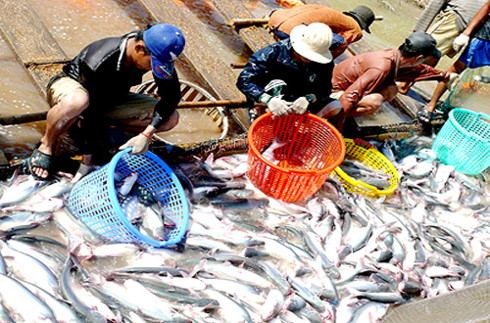 Fruit, vegetables, seafood and forestry products yield impressive growth Exports of fruit and vegetables soared by 40.5% to US$3.45 billion last year with the four largest importers being China Japan the US, and the Republic of Korea. In addition to the traditional markets, the gradual increase in quality of Vietnamese fruit has enabled it to conquer demanding markets such as the US, EU, Japan, Canada, Australia, and New Zealand. Nguyen Huu Dat, Secretary General of the Vietnam Fruit and Vegetable Association, says that following the momentum of growth in recent years, fruit and vegetables have spearheaded the rise in exports of agricultural products, surpassing even the traditional strongholds of rice and oil and gas. Mr Dat attributes the result to the exhaustive efforts of relevant agencies in diversifying markets and stimulating exports. Almost a year ago, shipments of cashew nuts were forecast to grow beyond the US$3 billion mark for the first time in 2017. In reality, they outperformed expectations by swelling to US$3.52 billion, with 353,000 tonnes of the nuts exported by the end of 2017, a rise of 23.8% in value and 1.9% in volume. The average price of raw cashews increased by 22.3% against the previous year. The US, Netherlands, and China remained the three largest consumers of Vietnamese cashew nuts with market shares of 35%, 15.6%, and 12.9%, respectively. The past decade has seen Vietnam edge ever closer to establishing itself as the world’s main cashew processing hub with the country leapfrogging India to become the primary cashew nut processor. Vietnam now processes 1.6-1.7 million tonnes out of the total global volume of 3.4 million tonnes of raw cashews every year. It holds the advantage of specialization when it comes to producing the most delicious cashew nuts in the world. Recently, many countries have imported advanced processing machines and technologies from Vietnam but processing factories in Africa have been unable to reproduce the quality and efficiency of Vietnam’s products. The forestry and seafood sectors made astonishing progress after setting new records by both reaching US$8 billion in export value.. Forestry exports grew 9.1% to US$8 billion with the three largest consumers being the US, China, and Correspondingly, seafood exports surged up by 18% to US$8.32 billion with the four biggest importers being the US, Japan, China, and the ROK accounting for 55.3% of total export value. Last year also provided a rebound for many agricultural products such as rice, coffee, rubber, cassava, and tea, however, they did not rally to the record levels they set several years ago. Conversely, last year saw the pig-farming industry wallow into crisis and a decline in the pepper and coffee sectors. Pepper exports rose by 20.5% to a volume of 214,000 tonnes but shrunk 21.9% in value to US$1.12 billion while coffee exports slumped, falling 20.2% in volume to 1.42 million tonnes and 3.8% in value to US$3.12 billion with the two biggest consumers- Germany and the US. Vietnam has so far exported nearly 200 different farm products abroad. The livestock industry is currently in the most unfavourable position among key agricultural industries. The country’s pork production was estimated at 2.75 million tonnes last year, ranking sixth in the world after China, the EU, the US, Brazil, and Russia. Most of the pork products were exported to China via unofficial channels. In 2016, nearly 12 million pigs were sold to China via such unofficial channels but in 2017 the channel was blocked, plunging the pig-farming industry into crisis. As a result, supply exceeded demand and prices tumbled, subjecting farmers to more than eighteen months of continual setbacks. Some experts say significant breakthroughs have not seen in exports of different kinds of Vietnamese meat over the years. In another unfavourable move, on October 23, 2017 the European Commission (EC) issued a "yellow card" warning to Vietnam, after the country failed to demonstrate sufficient progress in its fight against illegal, unreported, and unregulated (IUU) fishing worldwide. At present, seafood exports are proceeding as usual. But a yellow card could result in 100% of shipments from Vietnam to the EU undergoing strict checks, driving up the costs of storage and inspections. It could also undermine the confidence of importers in other markets. Hitting US$40 billion target this year The Ministry of Agriculture and Rural Development (MARD) has to resolve pending issues to ensure the fulfillment of the targeted US$40 billion export value this year. Firstly, greater efforts must be made to overturn the EU yellow card for seafood exports. It is imperative to fine-tune its management institutions, oversee fishing fleets in sustainably exploiting aquaculture resources, revamp the system to monitor and supervise fishing vessels at sea and in ports, certify the origin of seafood materials, and eliminate illegal fishing in foreign waters. The Law on Fisheries which has come into effect must be swiftly put into practise in order to ensure that fishing activities are in line with EU and international regulations. At the MARD’s review conference for 2017, Prime Minister Nguyen Xuan Phuc called for greater efforts to elevate agricultural exports target to US$40 billion this year. If weaknesses are remedied and advantages are fully exploited, the target will be achievable, he said. VOV |
↧
